Translate this page into:
Brief review on stab and cut protection materials: Material science physics and applications
⁎Corresponding author. muddasirhanif@yahoo.com (Muddasir Hanif)
-
Received: ,
Accepted: ,
This article was originally published by Elsevier and was migrated to Scientific Scholar after the change of Publisher.
Abstract
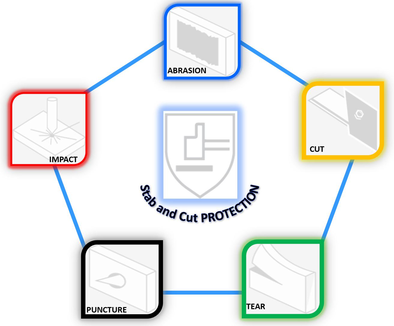
Abstract
Sharp object injuries affect a large number of people worldwide each year, including members of the public, doctors, nurses, security personnel, industrial specialists, and culinary staff. According to the USA National Crime Information Centre NCICCodeManual (September 2024): An instrument, weapon, or machine with an edge that can cut, puncture, stab, slash, chop, slice, push, or penetrate surfaces or materials is considered an EBLADE. Hence, protective clothing is essential to prevent the cuts to key organs and arteries, rapid blood loss, and eventual shock-induced deaths to save human casualties from any EBLADE circumstances. The difference between Stab and Cut protection is clearly mentioned with reference to common international standards used till 2024. This brief and comprehensive review has 8 sections, each of which focuses on a distinct facet of the protective materials. Abrasion, cut, tear, puncture, impact resistance, flexibility, and ergonomics are critical considerations for any protective clothing. Thus, we focused on the common materials of stab and cut protection such as Aramid (Kevlar®), Polyethylene (Dynema®), Polyester (PE), Polyamide (PA, Nylon), Carbon Fibres (CF), Composites, Steel fibre (or mesh) and Glass fibres. Kevlar and Dyneema are at the best materials, providing exceptional strength-to-weight ratios while delivering necessary cut and puncture resistance. To inspire further research, the preparation and properties of some of these materials are explained. The typical protective clothing standards (European, International, and USA) are presented with possible usage in different scenarios. Some manufacturers are mentioned to connect the researchers, industry, and users. In summary, this brief review comprehensively explains the important material science and physics that can inspire and help scientists, researchers, industry, and users of protective articles of clothing.
Keywords
Polymers
Stab-resistant garments
Protective clothing standards
Cut resistance
Steel mesh
1 Introduction
Traditionally, human civilizations have utilized metal, leather lamellae, horns, or wood as body protective clothing. (Wertmann et al., 2022; Brittanica, Modern armor, 2024) Modern protective clothing significantly improved due to advancements in textiles containing fibres, polymers, metals, and composites. (Brittanica, Modern armor, 2024; Panneke and Ehrmann, 2023; Fenne, 2005) Textiles produced for industrial purposes, designed and chosen for technical characteristics, are called technical textiles. Some examples of technical textiles (Horrocks and Anand, 2000) include automotive applications, medical textiles (implants), geotextiles (reinforcement of embankments), Agro textiles (crop protection), and Protective clothing (Fig. 1, stab protection, bullet protection, heat & radiation protection, and protection against molten metals). The research on protective clothing provides insights into materials that resist knife (sharp object) attacks and incidents. The research based on previous studies showed essential requirements for stab and cut protective clothing. (Panneke and Ehrmann, 2023; Fenne, 2005; Horrocks and Anand, 2000; Anand and Horrocks, 2016; Anand and Horrocks, 2016).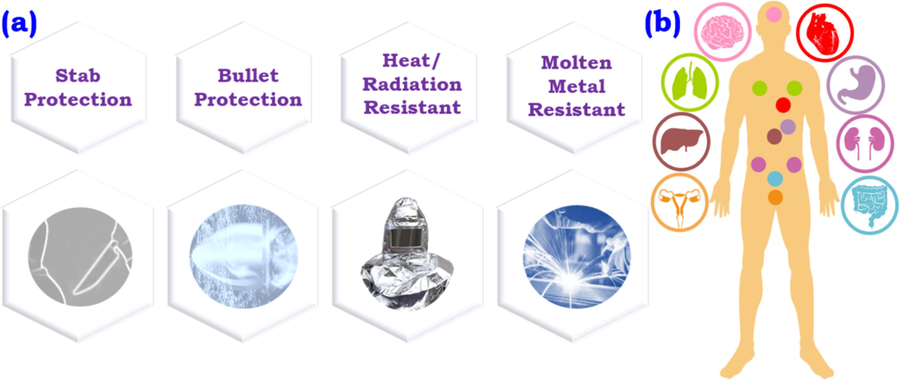
Examples of protective clothing (a), and the vital human organs (b).
A vest (stab-proof vest), is a strengthened body Armor worn over or under other clothing. Stab-proof vests (Soft and Hard) are specifically engineered to prevent penetration (Chest and abdomen) from sharp objects. The main aim of Stab-proof vests is to defend the user against chest, back, and side knife blows. Hence, users also need Cut Protection for the rest of the body parts. Cut Protection is the material's ability to resist damage when facing a moving sharp-edged object. Therefore, a wide range of modern sharp-object protection (Cut protection) products are important and available. In today’s world, both Stab and Cut protection are an essential aspect of personal safety. (Grainger®: Cut-Resistant Protective Clothing, 2024; Modern World Company for Industry: Cut Protection, 2024; CUTE-X®: Belize Shirt round neck, 2024; Kantor et al., 2024; Finch, 2019; Gani et al., 2023).
According to the United Nations, a Global study in 2017 on homicide (Fig. 2a) showed that 22 % of victims suffered from sharp objects. This study was published in 2019 and afterwards there is no new, free, or paid data available to public from the same online source until October 2024. (United Nations Office on Drugs and Crime, 2019) In China, hand injuries account for a large proportion of work-related 25 % of accidents. (Jin et al., 2010) USA official estimates (victims in the USA by weapon used) in 2016 and 2022 reported that 1604 and 1630 humans (STATISTA 2022, Database Company) were killed by knives or other cutting instruments (Fig. 2b). From the same source no further data available for the years 2023–2024 (Bethania Palma, Are Four Times More People Stabbed to Death Than Killed with Rifles, (Oct., 2017). In the UK, the incidents involving a knife or sharp instrument recorded in 2022/23 were 50.5 % based on the official open document source. (Grahame Allen, Helena Carthew, Yago Zayed, Research Briefing (House of Commons Library), (published October, 2023) A recent study (Situation and associated factors of needle stick and sharps injuries among health-care workers in a tertiary hospital: a cross-sectional survey) published in 2024 by X. Li, Q. He and H. Zhao reported 21.2 % of sharps injuries among health-care workers. (Li et al., 2024) Anyone interested in more data can read the references (Grahame Allen, Helena Carthew, Yago Zayed, Research Briefing (House of Commons Library), (published October, 2023; Li et al., 2024) and references within these documents. Therefore, to save human injuries, sharp-object-resistant garments play very important role by preventing cuts to arteries, rapid blood loss, and subsequent shock-causing fatalities (Patil et al., 2021). According to the USA official website (isp.illinois.gov) public file named NCICCodeManual (September 2024), an EBLADE is a word used to describe a tool, weapon, or machine with an edge that is designed to cut, puncture, stab, slash, chop, slice, thrust, or surfaces or materials. Some common stabbing items include but are not limited to the following: (a) lock knives, (b) sheath knives, (c) combat blades, (d) kitchen knives, (e) pointed weapons, (f) daggers, (g) awl, and (h) screwdriver. (The Crown Prosecution Service (CPS) et al., 2022) Therefore, stab and cut protection clothing may or may not include all the possible protection levels. Law enforcement, Military, Civilians, Industrial Professionals, Doctors, Nurses, Chefs, Bus drivers, and Ambulance workers may need stab-protective clothing at any time. The innovations in stab and cut protective clothing make them safer, more comfortable, and more versatile. The sharp-object protection standards and protection-clothing are divided into Stab/Spike and Cut protection (with sub-divisions). Therefore, following Table 1 shows main differences between the them. The following Scheme 1 enables the reader to comprehend the organization structure of this manuscript.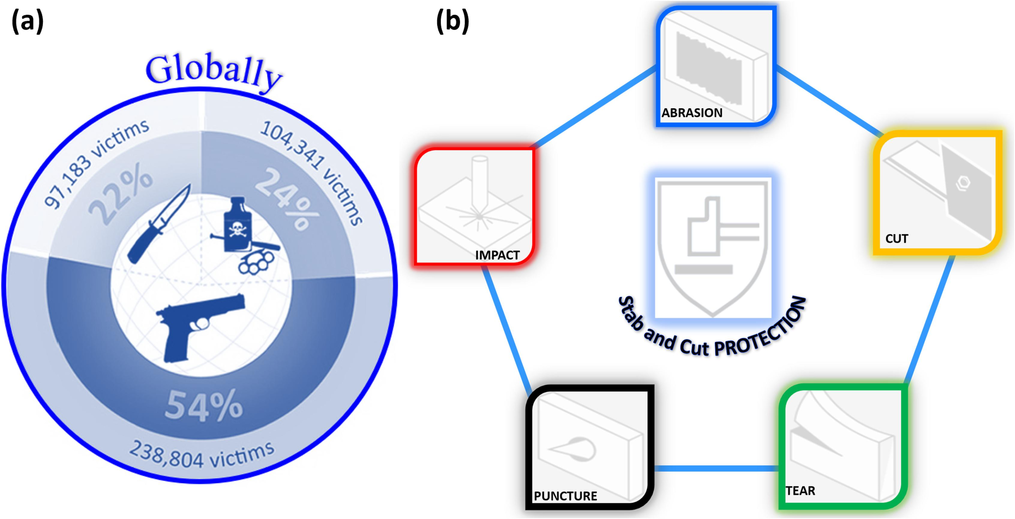
UN reported global sharp-object incident victims (a), Abrasion, Cut, Tear, Puncture, and Impact are examples of modern Cut protection (b) in which puncture resistance is very important for stab-protection.
Aspects
Cut Protection
Stab/Spike Protection
Type of Threat
Sharp, Slicing threats (Knifes, blades, glass, sharp edges).
Spike, Pointed, Deep Penetrating threats (Knifes, Nails, Needles).
Common Testing Standards
ANSI/ISEA 105, EN388:2016, ASTM F1790
HOSDB, NIJ 0115.00, NIJ 0115.01, ASTMF1342/F1342M-05(2022)
Testing Method
Measures resistance to cutting with a sharp Circular or Rectangular Blade.
Measures resistance to puncture or stabbing force with a Stabbing Blade: Similar to Knife (BS4659 BO1)
Standard Blade Movements
Horizontal (forward and reverse)
Vertical (up and down)
Main Focus
Blade cuts and slashes.
Deep Penetration from sharp, pointed objects.
Real life Scenarios/Mechanism


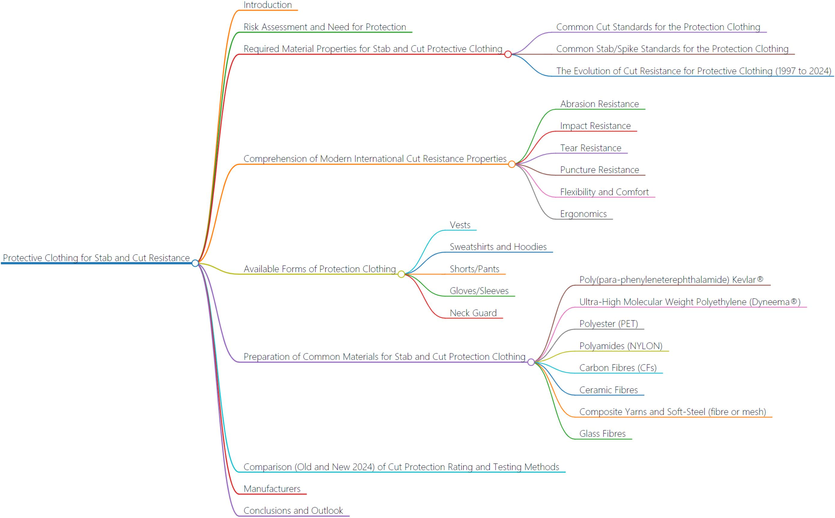
The organization of this manuscript.
This review article is divided into 8 main sections, each focusing on different aspects of protection. We have briefly examined the material science, physics principles, testing methods, and the standard ratings utilized for Cut/Knife/Stab/Spike protection research. (Conor O’Brien, Health and Safety Authority, Safety Representatives Resource Book, Third Edition, 2023; Infologue, 2023).
2 Risk assessment and need for protection
Stab-resistant vests are required for security, paramedics, traffic, environmental, customs, immigration, bailiffs, cash-in-transit, door supervisors/bouncers, and many others who may be threatened. Fig. 3 shows examples of stab protection required within different industries (Oyster processing (a), Poultry (b), Fish (c), Meat (d), Kitchen (e), Cheese, Bread (f), Leather, Paper, Clothing (g), Wood (h), Metal (i), Glass (j), Leather (k), Forest (l), Waste Processing (m), Construction (n) and Security Personnel (o)). (Timmis and Protection, 2024).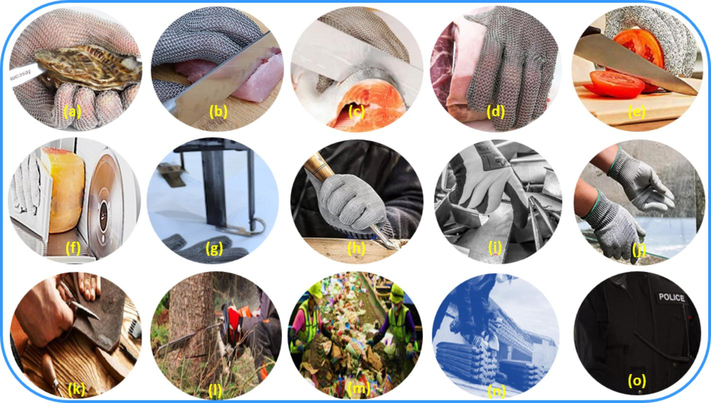
Examples of stab protection required within different industries: oyster processing (a), Poultry (b), Fish (c), Meat (d), Kitchen (e), Cheese, Bread (f), Paper, Clothing (g), Furniture (h), Metal (i), Glass (j), Leather (k), Forest (l), Waste Processing (m), Construction (n) and Security Personnel (o).
It's important to wear stab-proof clothing that protects against abrasion, cut, tear (slash), puncture, and impact. The USA National Institute of Justice (NIJ or US-NIJ, https://www.ojp.gov, pdf 183652) sets the maximum penetration depth for spikes or stabs at 7 mm (0.28″ inch) when applied perpendicularly to protective clothing material. This penetration limit was determined through research that indicated internal injuries to organs would be unlikely at 7 mm of penetration. (U.S. Department of Justice, National Institute of Justice (NIJ), The Law Enforcement and Corrections Standards and Testing Program, Stab Resistance of Personal Body Armor NIJ Standard–0115.00, (Sep., 2000) Therefore, laboratory certification is essential for stab-proof technical clothing. Please pay attention to the required National or International certifications before buying any stab-proof clothing.
3 Required material properties for stab and cut protective clothing
The mechanical properties of the material chosen for stab protective clothing should be strength, hardness, and toughness. (Available online: https://www.ojp.gov/pdffiles1/nij/, 2024; Zhai et al., 2021; Caple and Corporation, 2000; Aly and Stab, 2023; Crouch et al., 2017; Engineer and Strength, 2023; Rohan, 2023; Instrument, 2023) Strength is the ability to resist a tensile, compressive, or shear force. Hardness is the resistance to abrasion (deformation or indentation). Toughness is the ability to resist cracking (shock loading). When a sharp object pierces through the target material, it opens up the hole and penetrates (‘run through'). A good material should absorb or dissipate all of the stab energy before a run-through occurs. Several key properties, such as cut resistance, abrasion resistance, tear resistance, puncture resistance, and impact resistance, are essential to constructing effective protective clothing (Fig. 4). We will briefly discuss them.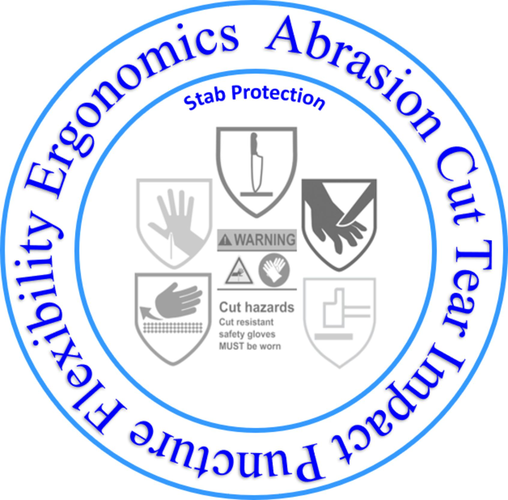
Important properties and warning symbols of stab protection.
3.1 Common International cut standards for the protection clothing
The common standards used to test the cut resistance of protective clothing valid and used till 2024 are the following (VPS, How to Measure the Tensile Strength of Fabric, (Apr., 2024; Mechanix B2B: Available online: https://b2b.mechanix.com/blog-categories/education/blog-understanding-cut-standards.html (Accessed November 1, 2024).
ANSI/ISEA 105–2016: This is the American standard for hand protection, which includes cut resistance testing. It uses a Tomodynamometer (TDM) to measure the force required to cut through the material. The higher the force required, the higher the cut resistance rating.
EN 388:2016: This is the European standard for hand protection, which also includes cut resistance testing. It uses two test methods: the Coupe test (rotating blade) and the ISO 13997 test (TDM). The Coupe test provides a rating from 1 to 5, while the ISO 13997 test provides a rating from A to F.
ASTM F1790: This standard covers the performance requirements for cut-resistant gloves. It includes testing for cut resistance, abrasion resistance, puncture resistance, and tear resistance.
3.2 Common International Stab/Spike standards for the protection clothing
The common standards used to test the Stab/Spike resistance of protective clothing valid and used till 2024 are the following: For the UK, the UK Home Office sets the standards for body protection. Besides the CE (European Standard CE) Mark, the Home Office Scientific Development Branch (HOSDB) standards provide a certificate for protective clothing. The HOSDB is now known as the Centre for Applied Science and Technology (CAST). According to HOSDB, Stab Resistance is the property of the material, or combination of materials, describing its/their ability to prevent perforation by a knife/spike or similar weapon. Protective clothing for civilian use falls under European Council Directive 89/686/EEC on Personal Protective Equipment (PPE), which states “any armor sold to civilian users must be CE (CE) approved.” (Kozane® Protection: Available online: https://www.kozaneprotection.com/cut-resistant-fabrics-and-global-cut-standards/ (Accessed November 1, 2024; Sitotaw et al., 2022).
Fig. 5 shows the machines for the Stab/Spike testing of a protective clothing and the impact energy and penetration are compared with the standards summarized in Table 2. The protection levels are tested mechanically in the Home Office laboratory; refer to the number of Joules (J) of energy from a knife (KR) and spike (SP) thrust conditions that protective clothing can withstand. The basic KR1 (Energy: 24 J, Knife Resistance Level 1) and SP1 (Spike Resistance Level 1) are the officially recommended stab and spike protection levels. The middle KR2 (Energy: 33 J, Knife Resistance Level 2) and SP2 (Spike Resistance Level 2) are the levels of stab and spike protection recommended for more dangerous police duties (higher risk scenarios, patrolling, airports, escorting prisoners). Similarly, the protection KR3 (SP3) level offers the highest protection against stab and spike threats, capable of withstanding 48 J of energy, and is recommended for those who regularly face severe knife threats. A red triangle indicates the stab/spike protection of HOSDB-certified clothing in the UK. (Nayak et al., 2018; Nayak et al., 2019; Home, 2024; Croft and Daniel Longhurst, 2007; Croft and Daniel Longhurst, 2007; Croft and Daniel Longhurst, 2024; Payne et al., 2017).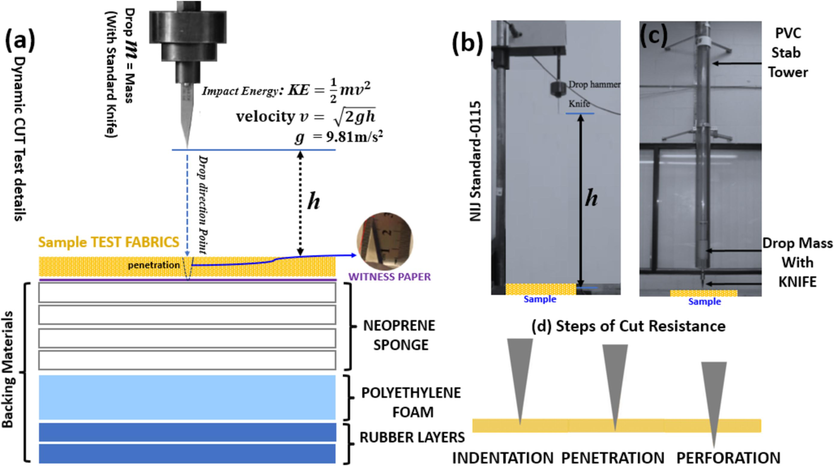
Dynamic STAB/SPIKE Tests: (a) Schematic of testing and backing material: 4 layers of 6 mm neoprene sponge, a single layer of 30 mm closed-cell polyethylene foam and two layers of 6 mm rubber. The drop mass contains NIJ standard blade (BS4659 BO1, West Yorkshire Steel Co Ltd, U.K.) total length = 100 mm with cutting edge = 33 mm, and a thickness = 2 mm; (b) Dynamic STAB/SPIKE Machine (without Stab Tower), (c) Dynamic STAB/SPIKE Test Machine (with PVC Stab Tower, CEAST 9350, Instron, U.S.A.), (d) 3 essential steps of STAB/SPIKE resistance.
Protection Level
Energy Level E1 (J)
Maximum Penetration at E1 (mm)
Energy Level E2 (J)
Maximum Penetration at E2 (mm)
KR1 (+SP1)
24
7 (SP1 = 0)
36
20
KR2 (+SP2)
33
7 (SP1 = 0)
50
20
KR3 (+SP3)
43
7 (SP1 = 0)
65
20
In the USA, the National Institute of Justice (NIJ) has established a stab-resistant body armour test standard (NIJ STD 0115.00, Fig. 9, Table 3), based on the previous work (the UK), which defines two threat types: spike and edged blade. Tests with commercial test threats are performed at energies of 24 J and 36 J, with penetration depths of 7 mm and 20 mm, respectively allowed. Body Armor Manufacturers can voluntarily submit samples for compliance testing through the National Law Enforcement and Corrections Technology Centre in Rockville, Maryland. Through the program, manufacturers can get certified that their protective clothing will defeat the specified threat at one of three threat levels. (Stab Resistance of Personal Body Armor, U.S. Department of Justice, Office of Justice Programs, National Institute of Justice (NIJ), NIJ Standard-0115.00, NCJ Number, 2000).
Protection Level
Threat Level
“E1” Strike Energy
“E2” Overtest Strike Energy
Joules (J)
Foot. Pound force (ft· lbf)
Joules (J)
Foot. Pound force (ft· lbf)
Level 1
Low
24 ± 0.50
17.7 ± 0.36
36 ± 0.60
26.6 ± 0.44
Level 2
Medium
33 ± 0.60
24.3 ± 0.44
50 ± 0.70
36.9 ± 0.51
Level 3
High
43 ± 0.60
31.7 ± 0.44
65 ± 0.80
47.9 ± 0.59
The three levels of protection presented in this standard were derived from a Police Scientific Development Branch (PSDB, 1997–1999) program where the frequency distribution of the energy that can be delivered by a male population using several stabbing techniques was characterized. For the first energy level, “E1,” A maximum blade or spike penetration of 7 mm (0.28 in.) is allowable. The penetration limit was determined through research indicating that internal injuries to organs would be extremely unlikely at 7 mm (0.28 in.) of penetration. The test protocol then requires an over-test condition where the knife blade or spike kinetic energy is increased by 50 %. At this higher energy condition, called “E2” a maximum blade or spike penetration of 20 mm (0.79 in.) is allowable. Threat levels 1, 2, and 3 are based on impact energies of 24 J, 33 J, and 43 J, respectively. (U.S. Department of Justice, Office of Justice Programs, National Institute of Justice, Stab Resistance of Personal Body Armor, NIJ Standard–0115.00 (Sep., 2000).
To calculate the impact energy, the following equations can be used as the Impact Energy = KE (Kinetic Energy) . (R Nave, Impact Force from Falling Object, Georgia State University, 2005; Grabowska et al., 2009) For these equations, m = mass (kg) of an object with an attached knife or spike falling due to gravity = 9.8 m/s2 from a height h (meter) onto the testing protective clothing sample. Stab-proof clothing with Protection Level 3 should be the best for the end users because it can sustain an impact energy of 43 Joules. (Runner and Protection, 2024) Based on these principles there are two similar International Stab/Spike tests that are reported. The first one (March 2020) is an extension of the old NIJ, renamed as NIJStandard-0115.01 (Draft: Stab Resistance of Personal Body Armor. National Institute of Standards and Technology: Gaithers burg, MD, USA, 2020). (NIJStandard–0115.01; Draft: Stab Resistance of Personal Body Armor. National Institute of Standards and Technology: Gaithers burg, MD, USA, 2020) The second one is ASTMF1342/F1342M-05(2022): (Standard Test Method for Protective Clothing Material Resistance to Puncture. ASTMInternational: West Conshohocken, PA, USA, 2022) (Standard Test Method for Protective Clothing Material Resistance to Puncture. ASTMInternational: West Conshohocken, PA, USA, 2022). They contain minor changes and details are available online.
3.3 The Evolution of cut resistance for protective clothing (1997 to 2024)
According to the Swedish Work Environment Authority report in 2017, there are about 3,500 hand injuries annually. The injuries are caused by sharp objects, which means that for every working day, roughly 14 hand-cut injuries occur that require medical attention. (Arbetsskador, 2017) Modern stab and cut protection clothing requires safety levels for abrasions, cuts, tears, punctures, and impacts. (Products and Guide, 2024; TILSATECH®, EN 388:, 2016) Hence, cut resistance refers to a material’s ability to withstand abrasion, cut, tear, puncture, and impact with minimal damage. Therefore, high material strength is essential to withstand an applied load (Stresses and Strains) through a machine (software) on a specimen (sample). High-material-strength synthetic Fibers like Aramid (Kevlar®) and Ultra-high-molecular-weight polyethylene or high-modulus polyethylene or UHMWPE (Dyneema® and Spectra®) are commonly used due to their high tensile and penetration resistance. (Sanborn et al., 2015; Priyanka et al., 2017) Kevlar is about 7 times stronger than steel, while UHMWPE is 15 times stronger than steel; therefore, it earned the title of the world’s strongest fibre. (Speciality, 2024) To further increase their strength, laminated materials and composites add additional layers of protection. (Wu et al., 2020; Cai et al., 2023; Li et al., 2023; Cheon et al., 2020; Rubin et al., 2019; Han et al., 2024; Yu et al., 2023; Sun et al., 2024).
Before further discussion, we need to get familiar with the following organizations that certify protective clothing (Fig. 5h). These organizations are (1) ANSI (The American National Standards Institute oversees standards and conformity assessment activities in the United States, 2024); (2) ISEA (Fig. 5d, International Safety Equipment Association (International Safety Equipment Association, 2024); (3) ASTM (Fig. 5b, American Society for Testing and Materials) (ASTM International: American Society for Testing and Materials, 2024); (4) EN or CE or CEN (Fig. 5a, European Committee for Standardization or Committee European de Normalization (Committee, 2024; Directive, 1983; laying down a procedure for the provision of information in the field of technical standards and regulations, 1983), and (5) ISO (Fig. 5c, International Organization for Standardization) (ISO: Global standards for trusted goods and services, 2024): Since 1946, As oldest non-governmental international organizations, ISO has enabled trade and cooperation between people and companies worldwide.
For any standard protective clothing, several standard ratings are available (Table 4, 5, Fig. 6, European/International/American), currently used for cut resistance. For the European and International EN 388 cut test ratings, the COUPE Test (Fig. 6f) cut score and ISO 13997 rating must be represented on the EN 388:2016 score. The ISO 13997 rating (TDM-100 Test, Fig. 6g) is represented by the letters A-F. This was further recently revised to include protection levels A (lowest) − I (highest). The North Americans (USA, Fig. 6, Table 5) also follow the TDM-100 test (ANSI/ISEA 105:2016 or ASTM F2992-15) with broader protection ratings (A1 (lowest) − A9 (highest)). (GlOVESNSTUFF, EN388:, 2016; HexArmor®, The revised EN388 standard: what’s changing, why, and what to look for, 2024; Daniel (Xuedong) Li, Chapter 2 - Evaluate cut resistance, Editor(s): Daniel (Xuedong) Li, In the Textile Institute Book Series, Cut Protective Textiles, Woodhead Publishing, 2020; HexArmor®, The top 3 cut testing facts, 2024; Adolphe and Dolez, 2018).
Miscellaneous Cut Protection Standards
Test
ASTM F2992-15
COUPE
ISO-13997
Organization
ANSI/ISEA
CE
CE
Standard
ANSI/ISEA-105:2016
EN 388
EN 388:2016
Origin of Standard
USA
Europe
Europe
Protection Levels Ratings
A1-A9
Cut 1–5
A-F, A-I
OLD EN388:2003
Level 1
Level 2
Level 3
Level 4
Level 5
−
COUPE cut machine Unit: Index
1.2
2.5
5.0
10.0
20.0
−
New EN388:2016
Level A
Level B
Level C
Level D
Level E
Level F
TDM-100 machine Unit: Newtons (N)
2
5
10
15
22
30
TDM-100 machine Unit: grams (g)
204
509
1020
1530
2243
3059
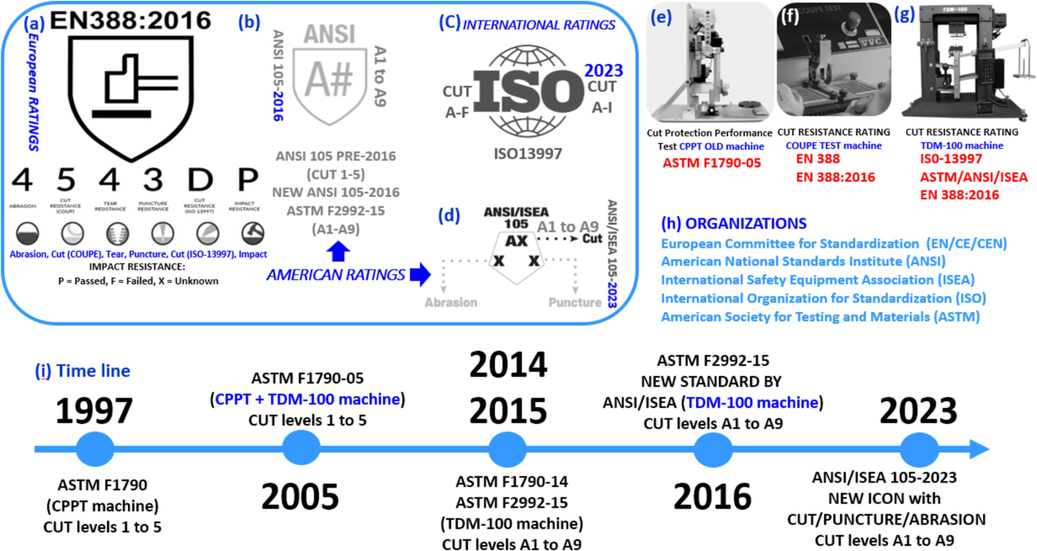
Important symbols and code ratings for stab/cut protection clothing: European (a), American Standard 2016 (b), International Standard (c), American Standard 2023 (d), CPPT machine (e), COUPE test machine (f), TDM-100 new machine (g), Organizations that certify protective clothing (h), Timeline of ANSI/ISEA protection ratings.
Before we start our discussion, we can understand the French word COUPE = cut, but for unknown reasons, it is also written as COUP. The cut resistance, according to the COUPE test machine (modified CPPT machine, Fig. 6e), involves a rotating circular blade of the COUPE test machine (Fig. 6f) moving horizontally (forward-reverse) across a fabric sample under a fixed force (5 Newtons). The test is completed when the blade “Cut Through” the sample material and an index value result is specified. This result is determined by the number of cycles needed to cut through the sample and additionally by calculating the degree of wear and tear on the blade. The protection level is indicated by a number between 1 and 20 (highest level of cut protection). However, if the sample material blunts the blade during the COUPE test, then the cut test from EN ISO 13997 (TDM-100 test) shall be performed. (Krauledaitė et al., 2023; Javid et al., 2024).
There are two variables in the TDM-100 test: applied force (Newton) and distance (millimeters), describing how far the blade can move before it cuts through the glove material. The standard TDM-100 cut test has the following steps: (1) A fresh (unused) blade is clamped into the testing apparatus, (2) A conductive copper (Cu) strip is affixed to a mandrel, covered with a layer of sample material and positioned, (3) The load (Weight/Force) is applied from the bottom of the sample with attached Cu-Strip, (4) The blade moves across the material, and the TDM stops automatically when the blade cuts through the sample and touches the conductive Cu-Strip, (5) The distance from initial contact to cut-through is measured in millimetres, (6) The test is repeated multiple times with different load weights, resulting in a range of cut-through distances, and finally (7) The TDM-100 test provides results in grams (A1-A9 ANSI/ISEA scale, Fig. 6b, 6d) or Newtons (A-I, ISO scale, Fig. 6c). In addition to TDM-100 cut tests, abrasion, impact, and puncture ratings are important. Therefore, we will briefly discuss the related details. (Messiry and El-Tarfawy, 2022; Deleanu et al., 2024; Li, 2020 Mar 23).
For the possible protection clothing usage scenarios following information is helpful for all. The cut resistance is low for ratings 1, 2, A, B, and A1, A2 (Force ≥ 2–5 N, Usage: General purpose, construction, warehouse, and automotive). The medium to high cut-resistance includes the ratings 3, 4, 5; C (Force ≥ 10 N, Usage: Oil & Gas), D (Force ≥ 15 Newtons, Usage: Manufacturing), E (Force ≥ 22 N, Usage: Metal Fabrication), F (Force ≥ 30 N, Usage: Metal Stamping). Similarly, the American ratings (Fig. 6b, 6d) A3, A4 (Automotive, Metal handling, Oil and gas), A5, A6, A7 (Construction, Machining, Paper production), A8, A9 (Assembly, Objects with Sharp Edges, Waste Management) provide medium, high and highest levels of protection. Fig. 6b shows the unified American ANSI code A1 (Lowest protection) to A9 (Highest protection). Similar to ANSI (Fig. 6c), the International Organization ISO 13997 has CUT levels A-I (A: lowest Protection Rating, I = Highest Protection Rating). In 2023, the American ANSI/ISEA 105–2023 standard adopted a new logo (Fig. 6d) for the Cut Protection that includes abrasion and puncture levels of protection. (Mao et al., 2024; Yan et al., 2020).
4 Comprehension of Modern (International) cut resistance properties
4.1 Abrasion resistance
The term “abrasion” refers to the process of scraping or wearing a test sample using friction through an abrader. The tests measure how resistant a material is to wear (scratching/rubs) over time.
Modern European standards (Fig. 5a) for protective clothing include an abrasive resistance rating in the first place. Previously, the abrasion resistance for clothes can be measured using the European (EN13595:2002) and International Standard (ISO 12947:1999, ISO 12947–2) assessment protocols according to the following equation: Abrasion Resistance = (mean abrasion time of specimens x 2.5)/reference abrasion time of cotton canvas. (Meredith et al., 2017; Meredith et al., 2014) More recently, the revised standard recommended a new type of abrasive sandpaper to be used during abrasion resistance (abrasiveness) testing under a determined amount of pressure through the Martindale abrasion machine. The Martindale abrasion machine uses Lissajous mathematical curves that originate from the harmonic motions (90° to each other) based on parametric equations: [{x (t) = A cos (ωx t − δx), y (t) = B cos (ωy t − δy)} or {x (t) = a sin (ωt + δ), y (t) = b sin (ωt)}; t = time; δ = phase angle (radians); a, b = wave amplitudes; ωx, ωy = x & y angular frequency components] that control the complex harmonic motion (Fig. 7). These curves can change based on phase angle δ and the ratio of ωx/ωy. The test results find the lowest number of cycles before creating a hole, which becomes the sample material’s abrasion rating. The protection level is indicated on a scale of 1 to 4, depending on the number of turns (cycles/rubs required to abrade, Table 6) until a hole appears. The higher the number (Table 7), the better the abrasion resistance. (Wiseworksafe, 2016; Coldea and Vlad, 2017; Testex Instrument, 2024).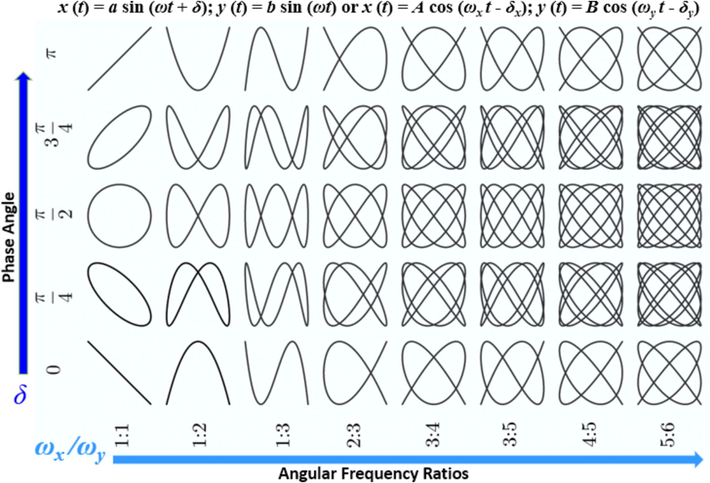
Lissajous mathematical curves based on the harmonic motions (parametric equations).
American ANSI Cut Standard
Protection Level
A1
A2
A3
A4
A5
A6
A7
A8
A9

Weight needed to Cut through (grams)
200
500
1000
1500
2200
3000
4000
5000
6000
Abrasion Resistance
Protection/Performance level
1
2
3
4
Abrasion Resistance (UNIT: Cycles)
100
500
2000
8000
4.2 Impact resistance
Impact test according to EN 13594:2015. Here, the absorption of the impact energy of 5 J on the absorption material (Sample) is tested. The Impact is an optional test; if protective clothing such as gloves has impact protection for hands, then it needs to be tested against impacts. Hand protection that can prevent or reduce force from heavy objects is critical to worker safety (machinery, moving pipe, drilling, extracting). New ANSI/ISEA 138–2019 standards for impact-resistant gloves were introduced in 2019 (Fig. 8), providing 3 classifications (1, 2, and 3: Peak Transmitted Force = 9 kN, 6.5 kN, 4 kN) of protection against impact hazards on knuckles and fingers.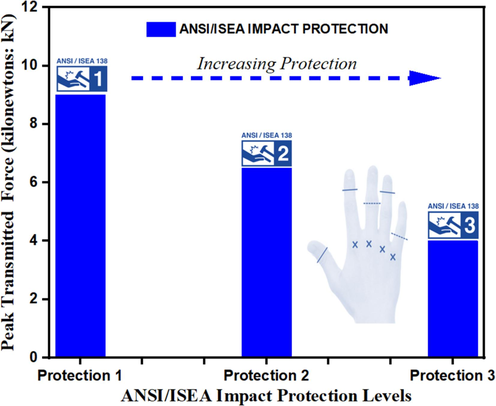
ANSI/ISEA 138–2019 Protection level standards for impact-resistant gloves.
The EN 388:2016 test for impact resistance is carried out under clause 6.9 of EN 13594:2015. The impact test consists of placing the protective back-of-hand knuckle impact material from the glove over a domed anvil (a block of metal with a flattened circular top surface) and dropping a 2.5 kg flat face surface striker from a sufficient height to provide an impact energy of 5 J (joules). A sensor beneath the anvil detects and records the peak force. To pass the test, the transmitted force needs to be less than or equal to 7 kN with no single results greater than 9 kN. If passed, display a letter “P”, and if they fail, an “F” will result. If protective clothing has not been tested for the impact, then an “X” will be indicated. (Sahoo et al., 2020).
4.3 Tear resistance
The resistance to a tear is the force necessary to propagate a tear in a specimen slit halfway along its length. Materials with high tear resistance ensure longevity. The protection function is indicated by a number between 1 and 4, where 4 indicates the strongest material (Table 8). A trouser leg-shaped piece of sample material is clamped to the top and bottom in a standard tensile test machine. The material is then pulled apart until it tears, and the force exerted is tested in Newtons. (Qin et al., 2017; Jiangbo et al., 2011).
Tear Resistance
Protection/Performance level
1
2
3
4
Tear Resistance (UNIT: Newtons)
10
25
50
75
4.4 Puncture resistance
Puncture resistance denotes a material or object's relative ability to inhibit a foreign object's intrusion. The puncture force is defined as the force required to pierce a test sample using a steel pin (pencil-like object) of specified dimensions. The test relates to the sample’s puncture resistance. The protection level is indicated by a number between 1 and 4, where 4 indicates the strongest material (Table 9). This EN388:2016 standard rating of puncture resistance test uses a rounded-point metal stylus pushed (by a force between 2–10 N perpendicular to the fabric) through the material using a tensile test machine. The force required to penetrate the material is measured in Newtons. The protection level is indicated by a number between 1 and 4 (highest protection). (Zhao et al., 2021; Wang et al., 2023).
Puncture Resistance
Protection/Performance level
1
2
3
4
Puncture Resistance (UNIT: Newtons)
20
60
100
150
4.5 Flexibility and comfort
The materials need to be flexible enough without compromising protection because the users may need to wear special clothing for extended periods. Therefore, key ways to ensure comfort are choosing lightweight, flexible clothing with multiple adjustment points. The comfort parameters (Air permeability (breathability), thermal transmission, water resistance, and flexibility) of protective clothing are evaluated according to ASTM-D737:2004, ASTM-D5470:2017, ISO-811:2018, and ASTM-D1388:2018, respectively. (Fan et al., 2022; Li et al., 2008).
4.6 Ergonomics
The protective clothing's thin and lightweight design should ensure that it fits well and does not hinder the wearer’s movement. For this aspect, an expert panel (ergonomics and topic specialist) assesses the clothing. While subjects of different statures wear the clothing, as well as by panel members. The clothing is evaluated for freedom of movement, proper design (overlap between jacket and trousers, arm length), and compatibility. The clothing performance is measured using consumer evaluation-type tables. (Bartkowiak et al., 2016; Irzmańska and Tokarski, 2017; Wang and Hazell, 2023 Oct) Now we have the basic idea of desired properties of cut protective clothing we need to think about common available forms of stab-Proof clothing.
5 Available forms of protection clothing
Protection clothing (Fig. 9, Table 10) comes in two categories: overt (over regular clothing) and covert (inside regular clothing). Overt is designed for law enforcement and military personnel; it is more robust and has a higher protection level. On the other hand, covert is designed for discretion and is most suitable for personal protection (low profile). Some available forms of Stab-Proof Clothing are given below. (Wei et al., 2011; Products and Vests, 2024; Panneke and Ehrmann, 2023; OK Fencing, Stab Proof T-shirt, 2018; Shi et al., 2023; Slash Pro®, Slash Resistant Neck Guard, 2024; Tran, 2024; Bac Tactical, Cut and Slash Resistant Clothing, 2024; Shield and Pants, 2024; Wells Lamont Industrial, Cut Resistant Sleeves, 2024; Chu et al., 2023).
Vests: Most anti-stab, cut, and slash vests are available online from retailers or manufacturers websites. The best are concealable and have pockets for additional protection. For example, a stab-resistant vest that meets level IIIA (US-NIJ standards) gives the best protection. In the UK, it’s not illegal to buy or sell protective clothing that isn’t certified by the Home Office. Hence, the end user needs to ensure adequate certified protection levels.
Sweatshirts and Hoodies: Comfortable sweatshirts and hoodies offer discreet cuts and puncture protection and are suitable for all-weather usage.
Shorts/Pants: Anti-slash shorts and pants are available to protect the vital femoral artery and lower torso.
Gloves/Sleeves: Anti-slash and stab-resistant gloves protect the radial and brachial arteries. These gloves often feature a good palm grip and improved wrist comfort (Table 10). The best quality gloves have exterior stainless-steel mesh that protects against knife attacks.
Neck Guard: A stab, cut, and slash-resistant neck guard shields users from damage to the carotid artery and jugular vein, which can cause severe bleeding. It is popular for neck, shoulder, and nearby area cut protection.
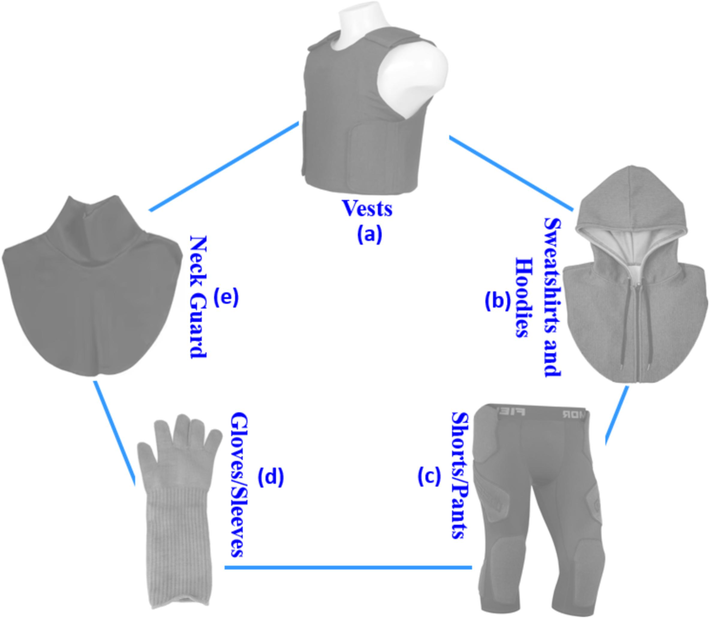
- Examples of stab and cut protective clothing (Vests, Hoodies, Shorts, Pants, Gloves, Neck Guard).

|
6 Preparation of common materials for stab and cut protection clothing
Anyone interested in research and development (R&D) of stab, cut, abrasion, puncture, and impact-resistant clothing should look for the following important materials (Bilisik, 2018; Bilisik, 2017; Srivastava et al., 2012; Nawaz Khan et al., 2022; Elkarem, 2020), preparations, and properties (Table 11). The worldwide common materials in stab-proof protective clothing are Aramid Fiber (e.g., Kevlar®), UHMWPE (e.g., Dynema®), Polyesters (PE), Polyamides (PA, Nylon), Carbon Fibre (CFs), Soft Steel (fibre or mesh), Composite Materials and Glass fibers. Let us briefly discuss them for better understanding.
Main Materials
Fiber Types/Trade names
Density (g/cm3)
Tensile modulus (GPa)
Tensile strength (MPa)
Strain to failure (%)
MP/Decomp. Temperature (oC)
KEVLAR®
Kevlar 29, DuPont
1.44
70
3300
4.2
550
Kevlar 129, DuPont
1.45
99
3400
3.3
Kevlar 49, DuPont
1.45
135
3300
2.8
Kevlar KM2, DuPont
1.44
70
3300
4.0
Technora, Teijin
1.39
70
3000
4.4
Twaron, Teijin
1.45
121
3100
2.0
Polyethylene-high molecular weight
UHMWPE
Spectra 900, Honeywell
0.97
73
2400
2.8
150
Spectra 1000, Honeywell
0.97
103
2830
2.8
Spectra 2000, Honeywell
0.97
124
3340
3.0
Dyneema, Toyoba/DSM
0.97
87
2600
3.5
Aromatic Polyester (PET)
Vectran
1.47
91
3200
3.3
150
Carbon fibres (PAN)
Celion
1.80
230
4000
1.8
1200
Aksaca
1.78
240
4200
1.8
Ceramic fibers
Nextel
2.50
152
1720
2.0
1200
Silicon carbide
2.80
420
4000
0.6
1300
6.1 Poly(para-phenyleneterephthalamide) Kevlar®
Aramid fibres (Scheme 2, 3a, 3b) are widely used in stab protection clothing due to their exceptional strength-to-weight ratio, which makes them lightweight, flexible, and high tensile strength. They work by distributing the force of an impact across the fibres, reducing the risk of penetration. Polish-American Stephanie Kwolek (female) invented Kevlar (1964) as a synthetic polymer at Delaware’s DuPont Laboratories (Wilmington). Kwolek patented her invention (1966), and Kevlar was first sold in 1971 by DuPont. DuPont is the largest legal producer of Kevlar in Northern Ireland, USA, and Japan. (Nawaz Khan et al., 2022; Elkarem, 2020).
Synthesis route to Poly(para-phenyleneterephthalamide) from the monomers.
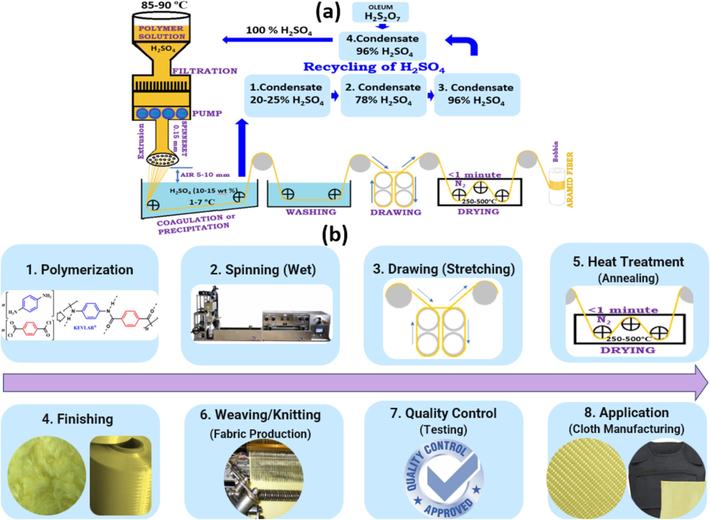
Schematic presentation for producing Aramid fiber (Wet Processing).
The reaction of 1,4-phenylene diamine (para-phenylenediamine) with terephthaloyl chloride initiates a process of repeated formation of amides (–CONH-) over and over again (Scheme 2, HCl released, by-product), to get polyamide poly(1,4-phenyleneterephthalamide) in which the amide groups (–CONH-) are separated by para-phenylene groups hence also called aramid (aromatic polyamide). Originally, the polymerization reaction solvent was hexamethylphosphoramide (HMPA), but later, other reaction conditions were reported. The more toxic HMPA solvent was replaced with less toxic solvent N-methyl-pyrrolidone and calcium chloride. The polymer obtained is dissolved in H2SO4 and is spun into fibres by a dry jet wet-spinning process (Scheme 3). The polymer gives an opaque solution that goes through the Spinning process (spinneret diameter: 0.05–0.1 mm) to get the Aramid/Kevlar fibres. The solvent, H2SO4 is later removed from the coagulation bath. Aramid fibre is also sold under Twaron (Tejin) and Heracron (Kolon) tradenames. The polymer product has liquid-crystalline behavior; therefore, mechanical drawing (Scheme 3a, 3b) orients the polymer chains in the fibre's direction. (Sabir, 2018; Kadir Bilisik, 2022; Knoff, 2017; Zahid and Chen, 2013; Yang, 2018; Yang, 2000; Kang and Kim, 2000; Jassal et al., 2020; Yang et al., 2020; Lv et al., 2021; Kong et al., 2023; Subhash et al., 2022; Elsheikhi and Benyounis, 2024; Sockalingam et al., 2017).
The production of Kevlar as a fabric is expensive due to the difficulties of using concentrated sulfuric acid (Scheme 3a). Keeping the water-insoluble polymer in an acid solution during processing is essential. The wet spinning process turns basic aramid into long, thin, and stiff fibres. During this process, a hot and highly viscous solution of poly(para-phenylene terephthalate) is pumped through an orifice with several hundred holes. After the fibers are processed, they are cut and woven. Kevlar is naturally yellow and five times stronger than steel; therefore, it is widely used in body armor applications as a fabric. Kevlar derives its strength from strong covalent and H-bonding between relatively short molecules. Kevlar is available as Kevlar staple (¼ inches or longer for making spun yarn); Kevlar floc (≥1 mm, for reinforcement in a variety of resin systems); and Kevlar pulp (to enhance the elastomers, thermoplastics, and thermosetting resins). (Akato and Bhat, 2017; Zhao et al., 2020; Larsen, 2024).
Tensile modulus (Young’s modulus: E = σ (tensile stress)/ ε (tensile strain)) is a mechanical property that measures the stiffness of a sample material. The parameter indicates how much a material can elastically deform under a particular load. The higher tensile modulus values indicate that more force is required to deform. Table 12 shows that Kevlar 149 has the highest tensile modulus (144 GPa) and is stiffer in the given series. (Larsen, 2024) According to the Environmental Protection Agency (EPA, USA): Kevlar solvent is an ‘unreasonable risk’ to human health. (Sheet, 2004) According to Material Safety Data Sheet (MSDS: SP1889, Dupont KEVLAR®, Brand Fibre, April 19th 2004), processing and handling can produce fibrils, and animal studies indicate prolonged exposure to such fibrils has the potential for lasting lung damage. (Merriman, 1989; Kevlar vs Dyneema (Qingdao Everpro Safety Product Co., Ltd., China), August, 2020).
Fibre
Characteristic
Tensile modulus (GPa)
Relative density (g/cm3)
Tensile strength (GPa)
Extension to break (%)
Kevlar 29
Regular
71
1.43
2.8
4.5
Kevlar 49
High modulus
134
1.46
2.8
2.9
Kevlar 129
High strength
98
1.46
3.5
3.2
Kevlar 149
Ultra-high modulus
144
1.48
2.4
1.6
Kevlar® (density = 1.4 g/cm3) is 5 times, and Dyneema® (density = 0.97 g/cm3) is 15 times stronger than steel. Both have similar tensile strengths (Table 11), but Dyneema® has a lower density; hence, Dyneema-based protective clothing is lightweight. Besides being lightweight, Dyneema® has lower manufacturing and environmental problems. On summer days, Dyneema® fibres stay cool against the skin and do not trap air, thereby allowing your skin to breathe. Dyneema® doesn't absorb water, which causes moisture and sweat to get rid of your skin. Kevlar® has lower breathability because it tends to absorb moisture. Hence, our next preferred material is Dyneema®. (SAINT, DYNEEMA® OR KEVLAR® (May, 2020; Zhou et al., 2021; Dyneema®, Designing to Deliver, End-to-End Sustainability, 2024; Kurtz, 2004).
6.2 Ultra-High molecular weight polyethylene (Dyneema®)
According to the website (https://www.dyneema.com), Dyneema® is an Ultra-High Molecular Weight Polyethylene (UHMWPE, UHMW) or high-modulus polyethylene (HMPE) fibre (strongest in the world) with exceptional safety, dependability, durability, and efficiency. UHMWPE is a thermoplastic polymer with molecular weights of multi-thousands to million amu. It resists friction, moisture absorption, corrosion, strong acids, alkalis, and organic solvents. The high crystallinity of crosslinked UHMWPE results in exceptional wear resistance. This can produce a fibre that is 15 times more robust than steel while still being buoyant enough to float on water. The UHMWPE fibres are great for protecting clothing vests due to excellent resistance against stab/cut/knife and spike attacks. They also have a high energy absorption capacity, which helps dissipate impact forces. Expansion of the chain improves intermolecular interactions, thereby making the most durable polymer with no taste, odor, toxicity, or highest impact resistance. (Stein, 1998; Park and Rutledge, 2017; Li et al., 2014).
By polymerizing ethylene, ultra-high-molecular-weight polyethylene (UHMWPE) is formed (Scheme 4). The UHMWPE molecules have 100,000 to 250,000. When formed into fibers, the UHMWPE polymer chains attain a parallel orientation greater than 95 % and a crystallinity level of 39–75 %. This crystallinity dictates the strength and other properties of UHMWPE. (Hawke et al., 2019; Wang et al., 2024; Zhang et al., 2018; Wang et al., 2021; Lin et al., 2021; Y. Fukushima H. Murase Y. Ohta Dyneema®: Super Fiber Produced by the Gel Spinning of a Flexible Polymer T. Society . of Fiber Science and Techno, J. High-Performance and Specialty Fibers, 2016; Brown et al., 2024) Complete UHMWPE (Mn = 8.3 × 106 g mol−1) synthesis details have been recently reported. (Iannucci et al., 2018; Yang et al., 2023; Lemstra, 2022; Baye and Tesfaye, 2022).
Synthesis route to Dyneema® from the monomers.
Dyneema® fibres are created (Scheme 5) through a gel-spinning process (Wijayanti et al., 2022; Rein et al., 2007; Sabarish et al., 2022), where a solution of polyethene with long chains are extruded and aligned. The material crystallizes, and the solvent is removed. During the drawing stage, the molecules are further stretched and aligned to the fibre axis, creating filaments wound over cylindrical support. Over time, the manufacturing process has been improved to produce different yarn grades with unique properties (Alagirusamy and Das, 2011; Scheirs and Long, 2003; Köpnick et al., 2000 Jun 15). The fibres can also be produced through commercially available electrospinning machines or an in-house electrospinning machine recently reported. (Hang et al., 2023; East, 1993).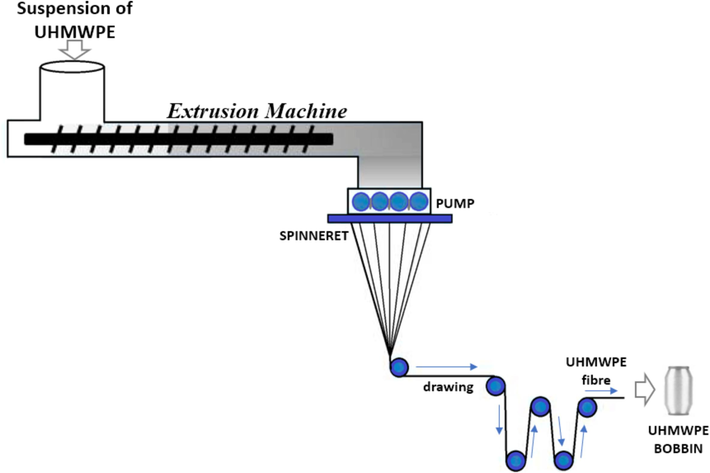
Gel Spinning Process for Ultra-high-molecular-weight polyethylene (UHMWPE) fibers.
6.3 Polyester (PET)
Polyethylene Terephthalate (PET), also known as Terylene or Dacron, is the widely used Polyester in the textile industry because of its cost-effective production and superior characteristics. The oleophilic and moisture-resistant nature of PET enhances its anti-stain, strength, tear, shrink, and wrinkle resistance. Most synthetic polymers are non-biodegradable except for a few synthetic polyesters and natural polyesters. Depending on the molecular weight and backbone, they have high glass transition temperature, melt at 250–280 °C, and soften at 230–250 °C, suitable for fibre formation (Scheme 6, 7). (Flores et al., 2018; Flory, 1952; Watanabe et al., 1983; Kong et al., 2014; Hu et al., 2020).
Synthesis route to Polyester from the monomers.
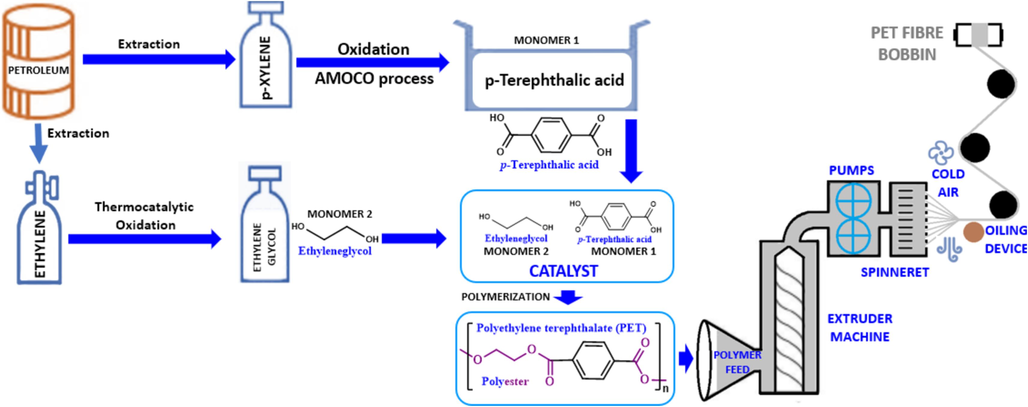
Schematic presentation for PET fibre production.
The manufacturing of PET (Terylene) involves terephthalic acid (TPA) or dimethyl terephthalate (DMT) (Scheme 6, 7) reacted a glycol in the presence of a catalyst by condensation polymerization with the elimination of water molecules. The reaction takes place at 150–210 °C temperature in the presence of zinc acetate Zn(CH3COO)2 and antimony(III) oxide or antimony trioxide (Sb2O3) as a catalyst. According to FIBER-LINE® (datasheet-petpolyester.pdf) available online, the density of PET is 1.38 g/cm3, Tensile Strength is 1.133 GPa, and Specific Strength is 0.821 MY. (Gan et al., 2021; FIBER-LINE®: Moving High-Performance Fibers Forward, 2024; El Messiry and Eltahan, 2016; Lou et al., 2011; Zhai et al., 2021; Hejazi et al., 2016; Lin et al., 2020) The creation of polyester fibre, Terylene (England), led DuPont to purchase (1946) the right to produce polyester in the USA. DuPont registered (1951) Dacron® as a trade name for the polyester (Terylene). Over time, various companies developed polyester fibres for various uses. Today, there are two primary types (Scheme 7): PET (polyethylene terephthalate) and PCDT or PCT: poly(1,4-cyclohexylene-dimethylene terephthalate)). PET is stronger and suitable for heavier consumer uses. PCDT is more elastic and resilient, making it suitable for wrinkle and stain-resistant clothing (Tg = 83 °C; Tm = melting point = 285 °C) with dimensional stability, resistance to high temperatures, and hydrolysis properties. (Mayo and Wetzel, 2014).
Chuang et al., suggested an interesting material combination when they prepared PET/PET fiber/matrix composites with woven carbon, aramid, and basalt fabrics. The test results indicate that the PET matrices and fibrous planks have good mechanical properties and excellent stab performance. (Chuang et al., 2019) Similarly, Ting Rui Lin et al., combined low-melting-point polyester staple fibres (S-type) and high-strength polyester filaments (F-type) with recycled Kevlar® fibres and nylon fibre. The test results indicate that the S-type (stab resistance is 415 N) sandwich composites outperform the F-type sandwich (stab resistance is 117.3 N) composites in terms of absorbing the puncture. (Lin et al., 2020) Many stab-proof clothing brands have been marketing polyester-based protective clothing with 5-star ratings. (Stab protection vest PRODEF®, 2024).
6.4 Polyamides (NYLON)
Nylon 6 and Nylon 6/12 (Scheme 8, 9) are both synthetic polyamide (Repeating amide: –CO-NH-) compounds. The most crucial difference between these two plastic materials is their moisture absorption tolerance level; nylon 6/12 (Tg = 46 °C) is more resistant to water and other liquids than nylon 6 (Tg = 54 °C). Both materials are used in similar industries (automotive, construction, and textiles). (Mohammadi et al., 2020; Goodman et al., 2000; Deng, 2002) Nylon 6 is synthesized by ring-opening polymerization of caprolactam (Scheme 8, 6 carbons) heated at (260 °C, 533 K) in an inert atmosphere of nitrogen-containing moisture (4 % H2O) for about 5 h; the ring breaks and undergoes polymerisation. The molten mass is then passed through spinnerets to form nylon 6 fibres. Both nylon 6 and nylon 6/12 may be easily used in plastic injection molding. (Carraher, 1978; Brooke and Whiting, 1997; Huang et al., 2019; Wu et al., 2023; McClements et al., 2024; 16 Different Types of Nylon Fiber (Properties and Applications) (Nov., 2021).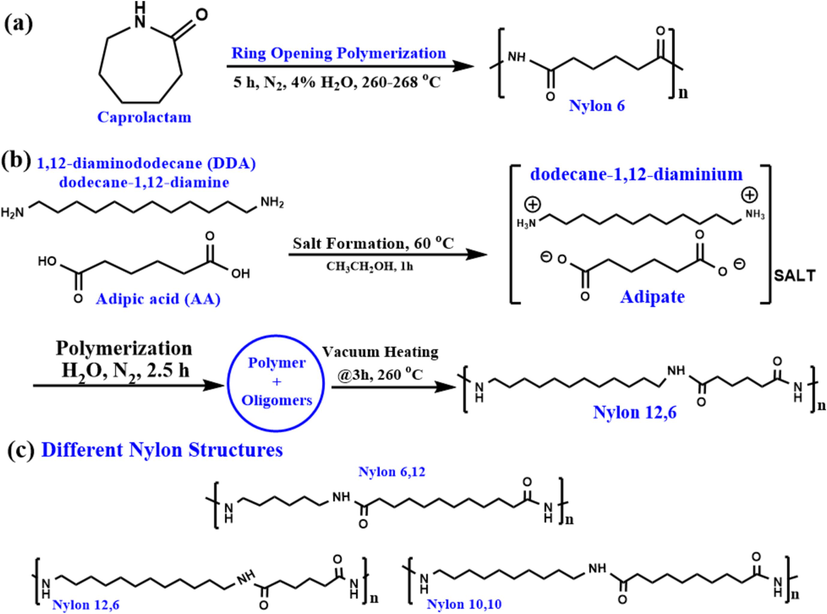
Synthesis route to Nylon 12,6 from the monomers Synthesis route to Nylon 12,6 from the monomers (b), common Nylon structures (c).

The important steps to make Nylon 12,6 (C18H36N2O3) based on DDA and AA.
The excellent complete synthesis details of Nylon 12,6 were reported (Chen G et al, 2019) (Chen et al., 2019) and simplified by us for easier comprehension (Scheme 8b and Scheme 9). Similar synthesis details and tensile strength for the polyamide 1010 (Scheme 8c) were reported by Yi-Dong Li et al., (2018), who discovered that both the tensile strength and the elongation at the break of the thermoset increased with the molecular weight of the oligomer. (Li et al., 2018) Urška Češarek and researchers reported Nylon polymers can be hydrolyzed into the constituent monomers at 200 °C at an HCl/amide mole ratio of 2.5. This indicates the recyclability of Nylon based polymers (Češarek et al., 2020).
Table 13 compares (McKeen, 2020; Sessini et al., 2021) the mechanical properties of common nylon-based polymers. Firouzi et al, suggested nylon 6,6 and nylon 6,12 coatings on UHMWPE fabrics to improve their stab resistance in dynamic and quasi-static tests. (Wu et al., 2022; Firouzi et al., 2014) Similarly, Kanesalingam et al., observed increased quasi-static stab and puncture resistance for silica coatings on Kevlar/wool and Kevlar/wool-nylon fabrics. (Kanesalingam et al., 2019).
Polymer
Tensile Strength (MPa)
Tensile Modulus (MPa)
Elongation break (%)
Bending Strength (MPa)
Flexural modulus (GPa)
Impact strength (KJ/m2)
Nylon 6
74
2,500
180
126
2.9
5.6
Nylon 6,12
62
2,000
200
83
2.0
5.4
Nylon 12,6
58
1,967
226
80
1.9
5.2
Nylon10,10
50
1,904
250
75
1.3
4.5
6.5 Carbon Fibres (CFs)
Most carbon fibres prepared from pyrolyzed polyacrylonitrile (PAN) have high tensile strength (stronger than Steel). Electrospinning, wet spinning or dry spinning techniques can produce PAN-based carbon fibres. In PAN fibres, the graphite planes are arranged along the fibre axis. Carbon fibre is important for textiles, aerospace, sports equipment and goods, generators, turbine blades and fuel tanks. (Jang et al., 2022; Jin et al., 2021; Choi et al., 2019) Carbon fibre stab vests have become popular recently due to their blunt force protection and lightweight nature. Carbon fibre stab vests form a shell around the user, which does not bend with the body and allows it to absorb more shock damage. The PPSS range is a good example of these carbon fibre stab vests. (Comprehensive Guide, 2023; Kaiser and Vests, 2023; Gregor-Svetec, 2022; Park and Seo, 2011).
6.6 Ceramic fibres
Ceramic fibres are found in continuous (long-length) and discontinuous (short-length). For example, Alumina- and silicate-based fibres are made using the sol–gel process, but short oxide fibres are made using the melt-spinning route. The common ceramic fibres are silicon carbide (SiC) and alumina (Al2O3). Two well-established and commercialized techniques for producing ceramic fibres are chemical vapor deposition (CVD) and spinning. CVD is generally used to produce silicon carbide fibres. The ceramic is deposited onto a heated tungsten or carbon filament via gaseous precursors that contain silicon atoms. In the spinning technique, a precursor polymer is spun into filaments. Consequently, these filaments are heated to obtain ceramic fibres commonly used to produce alumina fibres. (Bunsell et al., 1999; Yalamaç et al., 2017; Yalamaç et al., 2017; Kiran et al., 2018; Akram et al., 2013; Wallenberger, 1999) Recent research reported that protective clothing gives moderate protection with B4C or SiC and the best protection with Al2O3. (Boldin et al., 2021; Manaee et al., 2020; Jia et al., 2022).
Rubin Wei et al., showed Aramid (Kevlar) puncture resistance increases (79.9 %) manifold once Aramid made composite with SiC through epoxy resin (Table 14). (Wei et al., 2023) Similarly, Magdi El Messiry (2024) found that a silk layer exclusively coated (rice ash, aluminium oxide, and silicon oxide particles) exhibited stab resistance improvements of approximately 37.07 %, 29.21 %, and 13.47 %. The specific knife penetration depth indicated that the coating is more effective in diminishing penetration depth (National Institute of Justice Standard NIJ–0115.00). (El Messiry and Eltahan, 2024).
Fabric type
Areal Density (g/m2)
Puncture Force N
Puncture Force/Areal Density N.m2/kg
Aramid
200
15.1
75.5
SiC-Coated Aramid
360
42.7
118.6
SiC-Coated/STF Aramid
400
50.7
126.8
6.7 Composite yarns and Soft-Steel (fibre or mesh)
Composite yarns are made by combining two or more fibres/materials. For example, UHMWPE or Aramid fibre can deliver strength, comfort, and flexibility, and soft stainless steel (fibre or mesh) can deliver high-level cut resistance. When both (Aramid or UHMWPE and Soft stainless steel) are knitted together, the mechanical protection is much greater than when used alone. Chainmail with stainless steel rings is used for meat and metal-working industries when the highest protection is needed (Rebouillat et al., 2010; Guevel et al., 2006; Dolez et al., 2022; Schlegel J. Steel in Everyday Life. In The World of Steel: On the History, Production and Use of a Basic Material, 2023). In China, commonly used cut-resistant materials are mainly UHMWPE coated with spandex, glass fibre or steel fibres, meeting high wear resistance properties required by protective clothing (Li et al., 2022; Zhai et al., 2021). Poly(amide)6 and 66 (Nylon 6 and Nylon 66) have been widely used as engineering plastics in different applications. They possess high toughness, tensile strength, abrasion resistance, low density and friction coefficient, and easy processing. Aiming to improve their mechanical properties and tribological behaviour further, nylons were reinforced with some micro-particles or fibres, such as CuS, CuF2, CuO, PbS, CaO, CaS and carbon fibres: they were effective in reducing the wear rate of polyamides. (Bahadur et al., 1996).
The year 2022 research of Q. Liu, F. Chen, P. Ma et al., was inspired from Pangolin scales, reported a unique scale-like structural composite, intended to provide diverse protection. These reinforced with resin scale-like knitted fabric (R-SLKF) exhibit variable bending properties and combine good stab resistance with flexibility. The scale-like structure composite's excellent stab resistance is due to its surface hardness and internal tensile action. (Liu et al., 2022) Similarly, the year 2024 research of Q. Liu, F. Chen, P. Ma et al., was inspired from overlapping structure of Snake scales, developed a reinforced scale-like knitted fabric (R-SLKF). To do this, short carbon fibers in an epoxy resin (ER) matrix were embedded in the scales of an SLKF. The finished textile is a highly stable protective composite that is flexible, warm, and thermally insulated. Furthermore, solid protection blocks in the R-SLKF, which form a hard overlapping scale region, offer outstanding stabbing resistance, while soft twisted ultra-high-molecular-weight polyethylene yarn-based textiles provide adequate flexibility. The R-SLKF has strong stab resistance (peak load of 600 N for a single scale thickness of 2 mm), flexibility (∼290 mN cm), and breathability (100 MPa, 423 mm/s), along with good warmth retention and thermal insulation qualities. (Liu et al., 2024) These excellent researchers showed combination of structure and material design for future innovations and benefits for personal protective equipment in a variety of industrial fields for the fabrication of flexible and lightweight protective composite textiles.
6.8 Glass fiber
Glass fiber (or glass fibre) is a material consisting of numerous extremely fine fibers of glass. The most popular glass fiber is E-glass due to its properties such as tensile strength (3445 MPa), Compressive Strength (1080 MPa), Young’s modulus (76.0 GPa), Density (2.58 g/cm3), and Softening Temperature (846 °C). (Hull, 1996) Glass fiber has comparable mechanical properties to polymers and carbon fiber. Although not as rigid as carbon fiber, but low-cost and significantly less brittle when used as the composites. It has better damage tolerance for impact resistance and high strength. (Sathishkumar et al., 2014).
The research published in 2020 (Cheon et al., 2020) by the Jinsil Cheon, Minwook Lee, Minkook Kim reported fiber reinforced polymer composites (FRPs) made of three different types of fibers: carbon (CFRP), glass (GFRP) and p-aramid (AFRP). The CFRP had the most favorable and GFRP had moderate stab resistance compared to the AFRP. This was concluded because for the protection level 1 of the NIJ standard (penetration depth < 7 mm), the CFRP should be thicker than 2.6 mm, the AFRP should be thicker than 3.9 mm, and the GFRP should be thicker than 3.2 mm. Therefore, Glass fiber can play important role in the stab protection clothing development. However, the 1999 research (Occupational exposure to alkoxysilanes in a fibreglass manufacturing plant) by the Mäittälä found that the workers working with fiberglass (silanes: 3-aminopropyltriethoxysilane, 3-glycidoxypropyltrimethoxysilane and 3-methacryloxypropyltrimethoxysilane) suffered irritation through the skin and hands. (Mäittälä et al., 1999) Therefore, more research is required to safe-use fiberglass into stab and cut protection clothing to avoid the potential dangers of dermatitis. (Ceballos et al., 2014).
7 Comparison (Old and new valid till 2024) of cut protection rating and testing methods
Comparison of the European Union's Old (Fig. 10a, EN 388 Protection Rating Code: 4-numbers) and New Rating Standards (Fig. 10b, EN 388:2016 Protection Rating Code: 4-numbers + 2-Letters) indicates that EN 388 standard rating shows 4 different protection levels simplified as ACTP (A = Abrasion, C = Cut COUPE Test, T = Tear, and P = Puncture). The 4 ACTP numbers depend on tested protection levels (Fig. 11).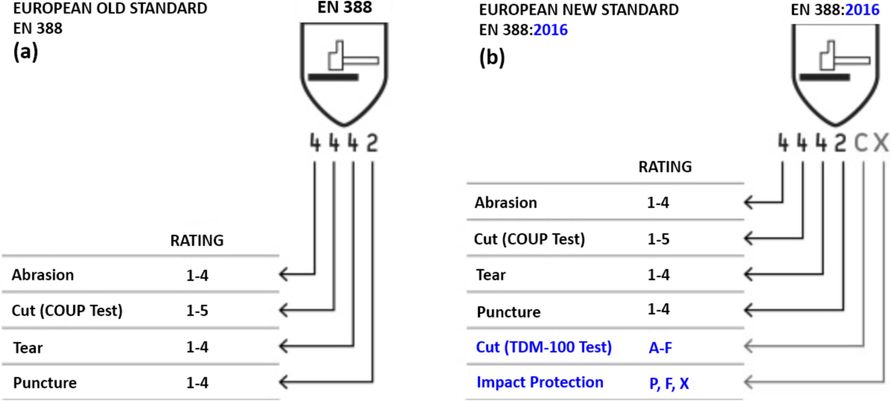
Comparison of European Union's Old and New Rating Standards for the Cut-protection.
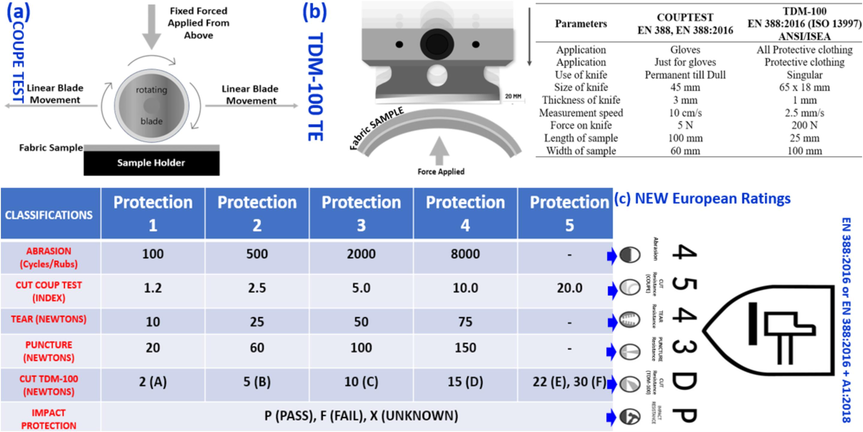
Comparison of the COUPE, TDM-100 Test machine and Parameters (a,b); The six different protection data with units for new European rating (EN 388:2016).
The new EN 388:2016 standard shows 2 additional (Fig. 10b) ratings. After testing, a CE (Conformité Européenne) certification is granted to verify an adequately tested product. This significant change happened on 4th November 2016 to the old EN 388 standard by formally including the ISO 13997 cut test method (TDM-100 Test) and Impact resistance. Later, the European Union standard protection rating was renamed EN 388:2016 and EN 388:2016 + A1:2018. This change became important because researchers discovered the blade used in the “COUPE Test” would dull quickly, causing unreliable cut scores for yarns containing high levels of steel. Therefore, this test isn’t recommended for materials with high cut resistance protection levels, leading to inaccurate results. The TDM-100 test is the gold standard (accepted by EN/CE/ANSI/ISEA/ISO), providing accurate and consistent data for assessing cut resistance (Horsfall et al., 1999; Hosur et al., 2008; Guo et al., 2020; Memon et al., 2020; Subhash et al., 2022; Kropidłowska et al., 2022; Ejendals, what is the difference between EN 388 and ANSI/ISEA, 2024).
Fig. 12 gives a comparison of new (ANSI-F2992-15), International ISO-13997, and Old (ANSI-1790–05) American National Standard Institute (ANSI) standards for stab/cut protection ratings. All the new protection standards prefer the TDM-100 machine (Tomodynamometer) for their cut-test method. The ANSI/ASTM F2992-15 cut test method features 9 levels of cut resistance (A1-A9, Unit: Grams, Fig. 12 left side). Additional levels were added to the higher end of the cut resistance scale to account for advanced cut-resistant materials. (ATG®, The standard, defines the performance values for gloves against mechanical risks such as abrasion, cut, tear, puncture, and, where applicable, impact, 2024; ANSI 105 EN 388: Cut-Resistant Glove Standards Explained (Nov., 2021; ANSI 105 EN 388: Cut-Resistant Glove Standards Explained (Nov, 2021; Blade Runner, Anti-Slash Protection, 2024).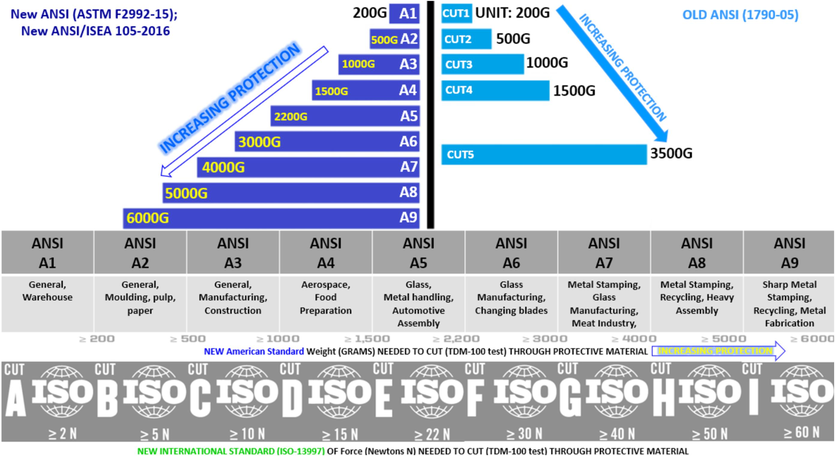
Comparison of New (ANSI-F2992-15), International ISO-13997, and Old (ANSI-1790–05) American National Standard Institute (ANSI) standards for stab/cut protection. All the possible user scenarios are mentioned.
The international cut protection ratings by the new ISO-13997 (Fig. 11) follow the similar scale but use different symbols (A-I) and the unit of Newtons. Therefore, a conversion factor that converts grams to newtons is essential (1 Newton = 101.97 g-force). (Newtons to Grams Converter, 2024) If we approximate 1 Newton = 100 Grams, the New ANSI cut protection rating A1 (200 G) will equal the ISO cut protection rating A (2 Newtons), the lowest protection. Similarly, the ANSI cut protection rating A9 (6000 Grams) will be approximately equal to the ISO cut protection rating I (60 Newtons), the highest Protection.
8 Manufacturers
It is difficult to find all the manufacturers. We found some popular brands of protective clothing materials. (Table 15). The pros and cons of materials are available directly from the suppliers’ websites or contact through mail. These and many other companies are well-known for their expertise in producing certified protection materials. For future research, all these brands and research groups are sources of inspiration and play an essential role in human protection because ensuring that any protective gear meets the required safety standards and certifications is essential.
Type of Materials
Manufacturers/Suppliers
Aramid Fibres
Argus™ (Barrday Inc.), Kevlar® MTP™ (DuPont), Twaron® SRM™ (Teijin-Twaron), Technora® (Teijin Aramid/Teijin), Spectra® (Honeywell), DuPont™ Nomex®
Carbon Fibres
CarbonX®, FLEXZORB®, TECGEN®, Spentex®, SGL Carbon, C-PLY™, C-WEAVE™, Celion, Aksaca®AKSA, Kundel Industries, Carbon Fiber Gear, Hexcel.
UHMWPE
Toyobo (Dyneema®: DSM, Nippon Dyneema), Zylon (International, Toyobo), Vectran (Celanese Corp., Kuraray), Beijing Tongyizhong New Material Technology Corporation (BJTYZ), HyFlex®, ActivArmr®, RINGERS® and AlphaTec®
Soft Steel/Metal Sheet Mesh
Everpro Safety, Cut-Tex® PRO, Saf-T-Gard®(saftgard), Qingdao Uneed Safety Products Co., Ltd., Linyi, Zhanda Safety Protective Product CO., Ltd., Hebei Wanchi Metal Wire Mesh Products Co., Ltd.
Composites
PAN Taiwan, TheUniformSolutions, KingFan-SG, Drager, Zhejiang Light-Tough Composite Material, ACP Composites, Epsilon Composite, Mitsubishi Chemical, Toray Industries, Infineon Technologies AG, TIP composite, Aerovac Composites One, Dockweiler Chemicals GmbH, Solvay SA, Spartec Composites, K. Sakai & Co. KeRui Refractory, Spartan Armor Systems®.
9 Conclusions
Stab and cut protective clothing are vital for industrial professionals, kitchen workers, doctors, nurses, security providers, high-risk professions, and the public. Understanding the protective clothing, certification levels, and the materials used in construction is essential for researchers working on protective clothing. For this purpose, abrasion resistance, cut resistance, tear resistance, puncture resistance, impact resistance, flexibility, and ergonomics are important factors. Therefore, we have explained Aramid (Kevlar®), Polyethylene (Dynema®), Polyester (PE), Polyamide (PA, Nylon), Carbon Fibres (PAN), Composites and Steel fibre (mesh). Kevlar and Dyneema are at the forefront, providing exceptional strength-to-weight ratios while delivering necessary cut and puncture resistance. The preparation and properties of some of these materials are provided to inspire further research. The typical stab/cut protective clothing standards (European, International and USA) are mentioned to help the researchers and end users. Some manufacturers are mentioned to connect the researchers, industry and users.
9.1 Outlook, challenges and possible solutions
For all the high and low-risk professionals, safety gear is particularly important because the EBlade scenarios pose serious threats on a daily basis. Hence use of anti-stab and anti-cut protective clothing should be mandatory. Developments in materials science, textile design, and manufacturing technique have been promoting the creation of a range of Protection clothing. Textiles that are flexible, breathable, and comfortable in addition to being able to withstand cuts and stabs are always needed. Manufacturers must integrate protection with contemporary comfort and style as industries realize how important it is to safeguard their employees. Fabric technologies and protective designs that may satisfy the various demands of professionals will be necessary.
The main technical challenges in stab and cut protection clothing are to achieve high performance, light weight, flexibility, durability, low-cost, compliance with safety standards and comfort. Additionally, ensuring consistency in the protective qualities of garments produced is essential for the mass production. Innovations in manufacturing processes, including 3D weaving and automated stitching, present potential solutions but require further exploration.
CRediT authorship contribution statement
Muddasir Hanif: Writing – review & editing, Writing – original draft, Software, Project administration, Methodology, Investigation, Funding acquisition, Formal analysis, Conceptualization. GuoQiang Zhang: Writing – review & editing, Visualization. Mahrukh Mahrukh: Writing – review & editing, Visualization, Software. Tariq Usman: Writing – original draft, Software, Formal analysis, Conceptualization. Xiaojie Li: Validation, Supervision, Conceptualization. Xuecheng Cao: Writing – review & editing, Visualization, Validation, Supervision, Funding acquisition, Conceptualization.
Acknowledgements
This research was funded by the Research Program of Qilu Institute of Technology, Shandong Province, Grant numbers: QIT23NN036 and QIT24NN078.
Declaration of Competing Interest
The authors declare that they have no known competing financial interests or personal relationships that could have appeared to influence the work reported in this paper.
References
- 16 Different Types of Nylon Fiber (Properties and Applications) (Nov. 2021) Available online: https://www.linkedin.com/pulse/16-different-types-nylon-fiber-properties-applications- (Accessed August 9, 2024).
- D.C. Adolphe, P.I. Dolez, Chapter 2 - Advanced strength testing of textiles, Editor(s): Patricia Dolez, Olivier Vermeersch, Valério Izquierdo, In the Textile Institute Book Series, Advanced Characterization and Testing of Textiles, Woodhead Publishing, 2018, Pages 25-57, ISBN 9780081004531.
- Akato K, Bhat G. Chapter 10, High-performance fibers from aramid polymers, structure and properties of high-performance fibers 2017 Jan 1 (pp. 245-266). Woodhead Publishing, ISBN 9780081005507.
- Comparative study of mechanical properties of e-glass/epoxy composite materials with Al2O3, CaCO3, SiO2, and PBO fillers. International Journal of Engineering Research & Technology.. 2013;2:1029-1034.
- [Google Scholar]
- R. Alagirusamy, A. Das, Chapter 2 - Yarns: Production, processability and properties, Editor(s): R. Fangueiro, In Woodhead Publishing Series in Textiles, Fibrous and Composite Materials for Civil Engineering Applications, Woodhead Publishing, 2011, Pages 29-61, ISBN 9781845695583.
- Aly NM, Hamouda T. Stab, spike and knife resistant textiles. In Advances in Healthcare and Protective Textiles, Pages 355-385, (Jan. 2023) Woodhead Publishing.
- Handbook of Technical Textiles, Volume 1, Second Edition: Technical Textile Processes. Woodhead Publishing 2016
- [Google Scholar]
- Handbook of Technical Textiles, Volume 2, Second Edition. Technical Textile Applications, Woodhead Publishing 2016
- [Google Scholar]
- ANSI 105 & EN 388: Cut-Resistant Glove Standards Explained (Nov 2021) Available online: https://www.ergodyne.com/sites/default/files/media/documents/ansi-105-en-388-what-you-need-to-know.pdf (Accessed August 9, 2024).
- ANSI 105 & EN 388: Cut-Resistant Glove Standards Explained (Nov. 2021) Available online: https://www.ergodyne.com/blog/ansi-105-en-388-what-you-need-to-know (Accessed August 9, 2024).
- Arbetsskador 2017: Reviderad version Occupational accidents and work-related diseases, (Aug. 2018), Available online: https://www.av.se/globalassets/filer/statistik/arbetsmiljostatistik-arbetsskador-2017-rapport-2018-1.pdf (Accessed August 9, 2024).
- ASTM International: American Society for Testing and Materials, (2024) Available online: https://www.astm.org/ (Accessed August 9, 2024).
- ATG®, The standard, defines the performance values for gloves against mechanical risks such as abrasion, cut, tear, puncture, and, where applicable, impact (2024). Available online: https://www.atg-glovesolutions.com/en/legal/standards/en-3882016a12018 (Accessed August 9, 2024).
- Available online: https://www.ojp.gov/pdffiles1/nij/183652.pdf (Accessed August 9, 2024).
- Blade Runner, Anti-Slash Protection, 2024. Available online: https://www.bladerunner.tv/en388-2016-summary/ (Accessed August 9, 2024).
- Bac Tactical, Cut and Slash Resistant Clothing, 2024. https://bac-tactical.com/product-category/cut-slash-resistant-clothing/ (Accessed August 9, 2024).
- Investigation of the influence of CaS, CaO and CaF2 fillers on the transfer and wear of nylon by microscopy and XPS analysis. Wear. 1996;197:271-279.
- [Google Scholar]
- Fabric Selection for the Reference Clothing Destined for Ergonomics Test of Protective Clothing: Physiological Comfort Point of View. AUTEX Research Journal. 2016;16:256-261.
- [Google Scholar]
- The new generation fibers: a review of high performance and specialty fibers. Polym. Bull.. 2022;79:9221-9235.
- [Google Scholar]
- Bethania Palma, Are Four Times More People Stabbed to Death Than Killed with Rifles, (Oct., 2017), https://www.snopes.com/fact-check/four-times-more-stabbed-than-rifles-any-kind/ (Accessed August 9, 2024).
- Two-dimensional (2D) fabrics and three-dimensional (3D) preforms for ballistic and stabbing protection: A review. Text. Res. J.. 2017;87:2275-2304.
- [Google Scholar]
- Bilisik K. Impact-resistant fabrics (ballistic/stabbing/slashing/spike). In Engineering of high-performance textiles 2018 Jan 1 (pp. 377-434). Woodhead Publishing.
- Review of ballistic performance of alumina: Comparison of alumina with silicon carbide and boron carbide. Ceram. Int.. 2021;47:25201-25213.
- [Google Scholar]
- Synthesis of oligomers related to nylon 6. J. Chem. Soc. Perkin Trans.. 1997;1(22):3371-3380.
- [Google Scholar]
- Ultra‐high molecular weight polyethylene micro‐ribbon fibers gel spun using orange terpenes. Polym. Eng. Sci.. 2024;64:1743-1755.
- [Google Scholar]
- Polyacrylate and Carboxylic Multi-Walled Carbon Nanotube-Strengthened Aramid Fabrics as Flexible Puncture-Resistant Composites for Anti-Stabbing Applications. ACS Appl. Nano Mater.. 2023;6:6334-6344.
- [Google Scholar]
- David Caple, South Australia Work Cover Corporation, Evaluation of Cut resistant gloves in the South Australian Meat Industry, (Feb. 2000), Available online: https://library.safework.sa.gov.au/attachments/5565/Evaluation of cut resistant gloves in the South Australian meat industry.pdf (Accessed August 9, 2024).
- Case studies: Evaluation of cut-resistant sleeves and possible fiberglass fiber shedding at a steel mill. J. Occup. Environ. Hyg.. 2014;11:D28-D33.
- [Google Scholar]
- Chemical recycling of aliphatic polyamides by microwave-assisted hydrolysis for efficient monomer recovery. ACS Sustainable Chem. Eng.. 2020;8:16274-16282.
- [Google Scholar]
- Synthesis and characterization of the novel nylon 12 6 based on 1,12‐diaminododecane. Polym. Eng. Sci.. 2019;59:192-197.
- [Google Scholar]
- Study on the stab resistance mechanism and performance of the carbon, glass and aramid fiber reinforced polymer and hybrid composites. Compos. Struct.. 2020;234:111690
- [Google Scholar]
- Fabrication of low-cost carbon fibers using economical precursors and advanced processing technologies. Carbon. 2019;142:610-649.
- [Google Scholar]
- A novel flexible and breathable stab-resistance fabric composites with ZnO nanowires growing technology. J. Mater. Res. Technol.. 2023;24:6438-6450.
- [Google Scholar]
- Mechanical and static stab resistant properties of hybrid-fabric fibrous planks: Manufacturing process of nonwoven fabrics made of recycled fibers. Polymers. 2019;11:1140.
- [Google Scholar]
- Research Regarding the Physical-Mechanical Properties of Knits for Garments- Abrasion Resistance. Procedia Eng.. 2017;181:330-337.
- [Google Scholar]
- The European Committee for Standardization, (2024) Available online: https://www.cencenelec.eu/ (Accessed August 9, 2024).
- A Comprehensive Guide to Stab Vests in the UK 2023 (June 2023), Available online: (Accessed August 9, 2024).
- Conor O’Brien, Health and Safety Authority, Safety Representatives Resource Book, Third Edition (2023), Available online: https://www.hsa.ie/eng/enterprise_and_employee_supports/safety_representatives/safety_representative_resource_book.pdf (Accessed August 9, 2024).
- John Croft, Daniel Longhurst, UK Home Office: Scientific Development Branch: HOSDB Body Armour Standards for UK Police Part 1: General Requirements (2007) Available online: https://www.bodyarmornews.com/wp-content/uploads/2013/10/HOSDB__2007_-_part_1.pdf (Accessed August 9, 2024).
- John Croft, Daniel Longhurst, UK Home Office: Scientific Development Branch: HOSDB Body Armour Standards for UK Police Part 2: Ballistic Resistance (2007) Available online: https://www.bodyarmornews.com/wp-content/uploads/2013/10/HOSDB__2007_-_part_2.pdf Accessed August 9, 2024.
- John Croft, Daniel Longhurst, UK Home Office: Scientific Development Branch: HOSDB Body Armour Standards for UK Police Part 3: Knife and Spike Resistance Available online: https://www.bodyarmornews.com/wp-content/uploads/2013/10/HOSDB__2007_-_part_3.pdf (Accessed August 9, 2024).
- I.G. Crouch, L. Arnold, A. Pierlot, H. Billon, Chapter 6 - Fibres, textiles and protective apparel, Editor(s): Ian G. Crouch, In Woodhead Publishing in Materials, The Science of Armour Materials, Woodhead Publishing, 2017, Pages 269-330.
- CUTE-X®: Belize Shirt round neck1162-25013PU-37 (2024), Available Online: https://www.cutex-cut-protection.com/sites/default/files/2021-06/1162-25013PU-37%20Belize%20EN.pdf (Accessed November 1, 2024).
- Daniel (Xuedong) Li, Chapter 2 - Evaluate cut resistance, Editor(s): Daniel (Xuedong) Li, In the Textile Institute Book Series, Cut Protective Textiles, Woodhead Publishing, 2020, Pages 15-58, ISBN 9780128200391.
- The Behaviour of Stratified Fabrics of Aramid Fibres under Stabbing Conditions. Polymers. 2024;16:882.
- [Google Scholar]
- Council Directive 83/189/EEC of 28 March 1983 laying down a procedure for the provision of information in the field of technical standards and regulations, Available online: https://eur-lex.europa.eu/legal-content/EN/TXT/?uri=CELEX:31983L0189 (Accessed August 9, 2024).
- Fibers and textiles for personal protective equipment: review of recent progress and perspectives on future developments. Textiles.. 2022;2:349-381.
- [Google Scholar]
- Dyneema®, Designing to Deliver, End-to-End Sustainability (2024), Available online: https://www.dyneema.com/sustainability (Accessed August 9, 2024).
- Anthony J. East, Preparation of aromatic Polyesters by Direct Self-condensation of Aromatic Hydroxy Acids, US Patent 4,393,191 (1993).
- Ejendals, what is the difference between EN 388 and ANSI/ISEA? (2024) Available online: https://ejendals.com/globalassets/new-structure/en-standards-gloves/en_en388_ansi-isea_highres.pdf (Accessed August 9, 2024).
- Stab resistance of triaxial woven fabrics for soft body armor. J. Ind. Text.. 2016;45:1062-1082.
- [Google Scholar]
- Enhancement of silk fabric knife-stabbing resistance for soft body armor. J. Ind. Text.. 2024;54:15280837241245903
- [Google Scholar]
- A study on Dyneema fabric for soft body armor. International Journal of Engineering Applied Sciences and Technology.. 2020;5:4.
- [Google Scholar]
- Salah Elsheikhi, Khaled Y. Benyounis, Chapter 12.31 - Review of recent developments in polymer matrix composites with fiber reinforcements, Editor(s): Saleem Hashmi, Comprehensive Materials Processing (Second Edition), Elsevier, 2024, Pages 414-428, ISBN 9780323960212.
- The Efficient Engineer, Understanding Material Strength, Ductility and Toughness, (Feb. 2023), Available online: https://efficientengineer.com/material-strength-ductility-toughness/ (Accessed August 9, 2024).
- Novel Kevlar fabric composite for multifunctional soft body armor. Compos. Part B Eng.. 2022;242:110106
- [Google Scholar]
- Fenne P. Protection against knives and other weapons. Scott RA, editor. Cambridge: Woodhead Publishing, CRC; 2005.
- FIBER-LINE®: Moving High-Performance Fibers Forward (2024), Available online: https://www.fiber-line.com/uploads/pdf%20US/fl.us.datasheet-petpolyester.pdf (Accessed August 9, 2024).
- Government proposal that nurses must report knife crime could undermine confidentiality. Br. J. Community Nurs.. 2019;24(5):244.
- [Google Scholar]
- Nylon‐coated ultra high molecular weight polyethylene fabric for enhanced penetration resistance. J. Appl. Polym. Sci.. 2014;131:40350.
- [Google Scholar]
- Screening of different organocatalysts for the sustainable synthesis of PET. Eur. Polym. J.. 2018;104:170-176.
- [Google Scholar]
- Paal J. Flory, Kent, and Frederick S. Leutne, Method of Preparing Linear Polyesters, US Patent 2,589,688 (1952).
- Facile synthesis of PET-based poly(ether ester)s with striking physical and mechanical properties. React. Funct. Polym.. 2021;164:104936
- [Google Scholar]
- Health outcomes in those who have been victims of knife crime: a protocol for a systematic review and meta-analysis. BMJ Open. 2023;13:e078020
- [Google Scholar]
- GlOVESNSTUFF, EN388:2016 Mechanical Handling - New Tests explained, (2024), Available online: https://www.glovesnstuff.com/en388-mechanical-handling-new-tests-for-2016 (Accessed August 9, 2024).
- 13C NMR spectra of nylon 6/12 copolymers and related model compounds. Eur. Polym. J.. 2000;36:1301-1311.
- [Google Scholar]
- Resistance to bullets, knives, stabs, and needles according to current standards, procedures and users' expectations. Techniczne Wyroby Włókiennicze.. 2009;17:90-95.
- [Google Scholar]
- Grahame Allen, Helena Carthew, Yago Zayed, Research Briefing (House of Commons Library), (published October 2023), https://researchbriefings.files.parliament.uk/documents/SN04304/SN04304.pdf, Accessed November 1, 2024.
- Grainger®: Cut-Resistant Protective Clothing (2024) Available online: https://www.grainger.com/category/safety/protective-clothing/cut-resistant-protective-clothing (Accessed November 1, 2024).
- Diana Gregor-Svetec, Chapter 14 - Polymers in printing filaments, Editor(s): Joanna Izdebska-Podsiadły, In Plastics Design Library, Polymers for 3D Printing, William Andrew Publishing, 2022, Pages 155-269, ISBN 9780128183113.
- Guevel, J.; Bontemps, G. Cut-Resistant Yarn Intended Especially for the Production of Protective Garments. U.S. Patent 7,065,949, 27 June 2006.
- Rapid prediction of polymer stab resistance performance. Mater. Des.. 2020;192:108721
- [Google Scholar]
- PMD/TiO2 gel/aramid fabric synergistically toughened to build soft composites with high puncture resistance and rapid self-healing. Compos. A Appl. Sci. Manuf.. 2024;176:107858
- [Google Scholar]
- Research progress on the synthesis of excellent impact and transparency polyesters with high glass transition temperature. Chemical Industry and Engineering Progress.. 2023;42:2555-2565.
- [Google Scholar]
- Nonequilibrium melt state of ultra-high-molecular-weight polyethylene: A theoretical approach on the equilibrium process. Macromolecules. 2019;52:8849-8866.
- [Google Scholar]
- Analytical assessment of woven fabrics under vertical stabbing–The role of protective clothing. Forensic Sci. Int.. 2016;259:224-233.
- [Google Scholar]
- HexArmor®, The revised EN388 standard: what’s changing, why, and what to look for, (2024), Available online: https://www.hexarmor.com/posts/revised-en388-standards-explained (Accessed August 9, 2024).
- HexArmor®, The top 3 cut testing facts, (2024), Available online: https://www.hexarmor.com/posts/the-top-3-things-you-should-know-about-cut-testing (Accessed August 9, 2024).
- UK Home Office: Police protective equipment Available online: https://ped-cast.homeoffice.gov.uk/index.php /standards/standards_display (Accessed August 9, 2024).
- A.R. Horrocks, S.C. Anand, Handbook of Technical Textiles 1 ed., CRC; 2000.
- An assessment of human performance in stabbing. Forensic Sci. Int.. 1999;102:79-89.
- [Google Scholar]
- Studies on the fabrication and stab resistance characterization of novel thermoplastic-kevlar composites. Solid State Phenom.. 2008;136:83-92.
- [Google Scholar]
- Synthesis of poly(ethylene terephthalate) based on glycolysis of waste PET fiber. J. Macromol. Sci. A. 2020;57(6):430-438.
- [Google Scholar]
- Synthesis and physical properties of non-crystalline nylon 6 containing dimer acid. Polymers. 2019;11(2):386.
- [Google Scholar]
- D. Hull T.W. Clyne “Fibres and Matrices”, An Introduction to Composite Materials, Cambridge Solid State Science Series (2 ed.), 1996 Cambridge University Press Cambridge 10.1017/cbo9781139170130.004 15.
- Understanding the thickness effect on the tensile strength property of Dyneema® HB26 laminates. Materials.. 2018;11:1431.
- [Google Scholar]
- Infologue, A Comprehensive Guide to Stab Vests in the UK 2023, (2024), Available online: https://www.infologue.com/exclusive/guide-to-stab-vests-uk-stab-proof/ (Accessed August 9, 2024).
- Darong Textile Instrument, what is fabric strength, and how to test, (May 2023), Available online: https://darongtester.com/what-is-fabric-strength-and-how-to-test/ (Accessed August 9, 2024).
- International Safety Equipment Association, (2024), Available online: https://safetyequipment.org/ (Accessed August 9, 2024).
- A new method of ergonomic testing of gloves protecting against cuts and stabs during knife use. Appl. Ergon.. 2017;61:102-114.
- [Google Scholar]
- ISO: Global standards for trusted goods and services, (2024), Available online: https://www.iso.org/home.html (Accessed August 9, 2024).
- Strategies for the production of PAN-Based carbon fibers with high tensile strength. Carbon. 2022;186:644-677.
- [Google Scholar]
- Jassal M, Agrawal AK, Gupta D, Panwar K. Aramid fibers. Handbook of fibrous materials. 2020 Apr 27:207-31. ISBN: 9783527342204.
- Statistical study and investigation of the cut-resistant and thermo-physiological performance of protective gloves: a new prospective. Int. J. Occup. Saf. Ergon.. 2024;30:399-411.
- [Google Scholar]
- Flexible ceramic fibers: Recent development in preparation and application. Adv. Fiber Mater.. 2022;4:573-603.
- [Google Scholar]
- Tear resistance of orthogonal Kevlar-PWF-reinforced TPU film. Chin. J. Aeronaut.. 2011;24:113-118.
- [Google Scholar]
- On the structural evolution of textile grade polyacrylonitrile fibers during stabilization and carbonization: Towards the manufacture of low‐cost carbon fiber. Polym. Degrad. Stab.. 2021;186:109536
- [Google Scholar]
- Patterns of work-related traumatic hand injury among hospitalised workers in the People's Republic of China. Inj. Prev.. 2010;16:42-49.
- [Google Scholar]
- Kadir Bilisik, Md Syduzzaman, 22 - Protective textiles in defense and ballistic protective clothing, Editor(s): Md. Ibrahim H. Mondal, In The Textile Institute Book Series, Protective Textiles from Natural Resources, Woodhead Publishing, 2022, Pages 689-749, ISBN 9780323904773.
- Robert Kaiser, Carbon Fibre Stab Vests (November 2023), Available online: https://www.ppss-group.com/blog/carbon-fibre-stab-vests/ (Accessed August 9, 2024).
- Stab and puncture resistance of silica-coated Kevlar–wool and Kevlar–wool–nylon fabrics in quasistatic conditions. Text. Res. J.. 2019;89:2219-2235.
- [Google Scholar]
- Energy-absorption mechanisms in Kevlar multiaxial warp-knit fabric composites under impact loading. Compos. Sci. Technol.. 2000;60:773-784.
- [Google Scholar]
- The 21-foot principle: Effects of age and sex on knife attack characteristics. J. Forensic Leg. Med.. 2024;101:102637
- [Google Scholar]
- Kevlar vs Dyneema (Qingdao Everpro Safety Product Co., Ltd., China), August 2020, Available online: https://www.everprogloves.com/kevlar-vs-dyneema/ (Accessed August 9, 2024).
- Evaluation of mechanical properties of glass fiber reinforced epoxy polymer composites with alumina, titanium dioxide and silicon carbide fillers. Mater. Today Proc.. 2018;5:22355-22361.
- [Google Scholar]
- Aramid Structure/Property Relationships and Their Role in Applications Development. Handbook of Fiber Science and Technology Volume 2: High Technology Fibers. Part b.. 2017;64:35.
- [Google Scholar]
- Synthesis and characterization of high‐molecular weight aliphatic polyesters from monomers derived from renewable resources. J. Appl. Polym. Sci.. 2014;131(15):40579.
- [Google Scholar]
- Intensive and thermally conductive boron nitride/aramid nanofiber composite fibers fabricated via a wet spinning technique. J. Mater. Chem. C. 2023;11:14671-14679.
- [Google Scholar]
- Polyesters. Ullmann's Encyclopedia of Industrial Chemistry. Weinheim: Wiley-VCH; 2000 Jun 15.
- Kozane® Protection: Available online: https://www.kozaneprotection.com/cut-resistant-fabrics-and-global-cut-standards/ (Accessed November 1, 2024).
- The influence of high molecular weight polyethylene and basalt content on the mechanical risks of protective three-dimensional weft-knitted fabrics designed to wear next to skin. Text. Res. J.. 2023;93:3020-3035.
- [Google Scholar]
- Preliminary Experimental Investigation of Cut-Resistant Materials: A Biomimetic Perspective. Autex Research Journal.. 2022;22:411-418.
- [Google Scholar]
- The UHMWPE handbook: ultra-high molecular weight polyethylene in total joint replacement. Academic Press; 2004.
- Patrick Larsen, Kevlar solvent an ‘unreasonable risk’ to human health, EPA says (Published July 18, 2024) Available online: https://www.vpm.org/news/2024-07-18/epa-kevlar-dupont-health-risk-chesterfield (Accessed August 9, 2024).
- laying down a procedure for the provision of information in the field of technical standards and regulations, (1983), https://eur-lex.europa.eu/legal-content/EN/TXT/PDF/?uri=CELEX:31983L0189 (Accessed August 9, 2024).
- Cut protective textiles. Woodhead Publishing; 2020 Mar 23.
- Preparation of body armour material of Kevlar fabric treated with colloidal silica nanocomposite. Plast., Rubber Compos.. 2008;37:223-226.
- [Google Scholar]
- Silica Nanoparticle/TPU Coating Imparts Aramid with Puncture Resistance and Anti-corrosion for Personal Protection. ACS Appl. Nano Mater.. 2023;6:16986-16999.
- [Google Scholar]
- Situation and associated factors of needle stick and sharps injuries among health-care workers in a tertiary hospital: a cross-sectional survey. BMC Health Serv Res. 2024;24:1002.
- [Google Scholar]
- Stab resistance of UHMWPE fiber composites impregnated with thermoplastics. Polym. Adv. Technol.. 2014;25:1014-1019.
- [Google Scholar]
- Fully biobased and high performance epoxy thermosets from epoxidized soybean oil and diamino terminated polyamide 1010 oligomers. Polym. Test.. 2018;72:140-146.
- [Google Scholar]
- Comparison of three methods for measuring the bending stiffness of ultrafine metal wires. Mater. Test.. 2022;64:132-142.
- [Google Scholar]
- Impact resistance of fiber reinforced sandwich-structured nonwoven composites: Reinforcing effect of different fiber length. Mater. Today Commun.. 2020;24:101345
- [Google Scholar]
- Living aqueous microemulsion polymerization of ethylene with robust Ni(II) phosphinophenolato catalysts. J. Am. Chem. Soc.. 2021;143:20605-20608.
- [Google Scholar]
- Excellent flexibility and stab-resistance on pangolin-inspired scale-like structure composite for versatile protection. Compos. Commun.. 2022;35:101266
- [Google Scholar]
- Pibo Ma, Large-scale Fabrication of Snake-skin-inspired Protective Composite Textiles. Adv. Fiber Mater.. 2024;6:978-992.
- [Google Scholar]
- Processing technique and property evaluation of stab-resistant composite fabrics. Adv. Mat. Res.. 2011;239:683-686.
- [Google Scholar]
- Post-construction of weaving structure in aramid fibre towards improvements of its transverse properties. Compos. Sci. Technol.. 2021;208:108780
- [Google Scholar]
- Brittanica, Modern armor, 2024. Available online https://www.britannica.com/topic/armour-protective-clothing/Modern-armour (Accessed August 9, 2024).
- Occupational exposure to alkoxysilanes in a fibreglass manufacturing plant. Int. Arch. Occup. Environ. Health. 1999;72:539-545.
- [Google Scholar]
- The effect of bond coat type on the stab resistance of an Al2O3–13 wt% TiO2 plasma-sprayed ceramic coating on aramid fabrics. Surf. Interfaces. 2020;18:100432
- [Google Scholar]
- Cut/Puncture resistance and mechanisms of protective composite textiles reinforced with inorganic powder. Mater. Des.. 2024;237:112575
- [Google Scholar]
- Cut resistance and failure of high-performance single fibers. Text. Res. J.. 2014;84:1233-1246.
- [Google Scholar]
- Dean McClements, Aaron Lichtig, The Differences, Advantages, and Disadvantages of Nylon 6 and Nylon 6/12, (Aug. 2024) Available online: https://www.xometry.com/resources/materials/nylon-6-and-nylon-6-12/ (Accessed August 9, 2024).
- Laurence W. McKeen, Chapter 6 - Effect of Radiation on the Properties of Polyamide Polymers, Editor(s): Laurence W. McKeen, In Plastics Design Library, The Effect of Radiation on Properties of Polymers, William Andrew Publishing, 2020, Pages 153-191.
- Mechanix B2B: Available online: https://b2b.mechanix.com/blog-categories/education/blog-understanding-cut-standards.html (Accessed November 1, 2024).
- Performance evaluation of conventional and hybrid woven fabrics for sustainable personal protective clothing development. Environ. Sci. Pollut. Res.. 2020;27:33835-33847.
- [Google Scholar]
- Distribution and type of crash damage to motorcyclists’ clothing: validation of the zone approach in the European standard for motorcycle protective clothing, EN13595. Traffic Inj. Prev.. 2014;15:501-507.
- [Google Scholar]
- Liz de Rome, Olivier J, Brown J, Validation of the abrasion resistance test protocols and performance criteria of EN13595: The probability of soft tissue injury to motorcycle riders by abrasion resistance of their clothing. J. Saf. Res.. 2017;61:1-7.
- [Google Scholar]
- Merriman EA. Safe use of Kevlar aramid fiber in composites. In Conference on Occupational Health Aspects of Advanced Composite Technology in the Aerospace Industry 1989 Mar (pp. 177-182).
- Cutting resistance of flexible armour using multiple layers of triaxial kevlar fabric. J. Ind. Text.. 2022;51:1564S-S1591.
- [Google Scholar]
- Modern World Company for Industry: Cut Protection (2024) Available online: https://modernworldsafety.com/cut-protection/(Accessed November 1, 2024).
- Structure architecture and morphology changes study in nylon 6/12 copolymers through anionic copolymerization via Response Surface Methodology Modeling. Polymer. 2020;188:122093
- [Google Scholar]
- Body armor for stab and spike protection, Part 1: Scientific literature review. Text. Res. J.. 2018;88:812-832.
- [Google Scholar]
- Body armor for stab and spike protection, Part 2: a review of test methods. Text. Res. J.. 2019;89:3411-3430.
- [Google Scholar]
- Newtons to Grams Converter, 2024. Available online: https://www.inchcalculator.com/convert/force-newton-to-gram-force/ (Accessed August 9, 2024).
- NIJStandard–0115.01; Draft: Stab Resistance of Personal Body Armor. National Institute of Standards and Technology: Gaithers burg, MD, USA, 2020. 20. ASTMF1342/F1342M-05(2022); Available online: https://nij.ojp.gov/sites/g/files/xyckuh171/files/media/document/nij-standard-0115-01-stab-resistance-of-body-armor-draft-for-public-comment.pdf (accessed on November 1, 2024).
- OK Fencing, Stab Proof T-shirt, 2018. Available online: https://www.okfencingequipment.com/stab-proof-t-shirts/ (Accessed August 9, 2024).
- Stab-resistant polymers-recent developments in materials and structures. Polymers. 2023;15(4):983.
- [Google Scholar]
- Soo-Jin Park, Min-Kang Seo, Chapter 6 - Element and Processing, Editor(s): Soo-Jin Park, Min-Kang Seo, Interface Science and Technology, Elsevier, Volume 18, 2011, Pages 431-499, ISSN 1573-4285.
- Design and synthesis of a new topical agent for halting blood loss rapidly: A multimodal chitosan-gelatin xerogel composite loaded with silica nanoparticles and calcium. Colloids Surf. B Biointerfaces. 2021;198:111454
- [Google Scholar]
- T Payne, S O’Rourke, C Malbon, UK Home Office Body Armour Standard 2017, (July 2017), Available online:https://assets.publishing.service.gov.uk/media/5a82b254ed915d74e62372c8/Home_Office_Body_Armour_Standard.pdf (Accessed August 9, 2024).
- High-Strength Hybrid Textile Composites with Carbon, Kevlar, and E-Glass Fibers for Impact-Resistant Structures. A Review. Mechanics of Composite Materials.. 2017;53:685-704.
- [Google Scholar]
- IP Products, Comprehensive Guide to Cut Resistant Protective Clothing, (2024), Available online: https://ipproducts.com/comprehensive-guide-cut-resistant-protective-clothing/ (Accessed August 9, 2024).
- Interconnective Security Products, Stab Vests, (2024), Available online: https://www.interconnective.co.uk/body-armour-vest/security-stab-vest/ (Accessed August 9, 2024).
- Dynamic/quasi-static stab-resistance and mechanical properties of soft body armour composites constructed from Kevlar fabrics and shear thickening fluids. RSC Adv.. 2017;7:39803-39813.
- [Google Scholar]
- R Nave, Impact Force from Falling Object, Georgia State University (2005), Available online: http://hyperphysics.phy-astr.gsu.edu/hbase/flobi.html (Accessed August 9, 2024).
- Aramid, steel, and glass: characterization via cut performance testing, of composite knitted fabrics and their constituent yarns, with a review of the art. J. Mater. Sci.. 2010;45:5378-5392.
- [Google Scholar]
- Electrospinning of ultrahigh‐molecular‐weight polyethylene nanofibers. J Polym Sci B. 2007;45:766-773.
- [Google Scholar]
- Rohan, Knowing Fabric, Beginner’s Guide to Evaluating Fabric Quality, (Nov. 2023), Available online: https://knowingfabric.com/beginners-guide-to-evaluating-fabric-quality/ (Accessed August 9, 2024).
- Enhancing stab resistance of thermoset–aramid composite fabrics by coating with SiC particles. J. Ind. Text.. 2019;48:1228-1241.
- [Google Scholar]
- Blade Runner, Anti-Slash Protection (2024) Available online: https://www.bladerunner.tv/stab-resistant-clothing/ (Accessed August 9), 2024.
- Radoor Sabarish, Senthilkumar Krishnasamy, Suchart Siengchin, Karayil Jasila, Malayil Vintu, Mannekote Shivanna Jyothi, Chandrasekar Muthukumar, Senthil Muthu Kumar Thiagamani, Rajini Nagarajan, Plastics in Fabric, Textile and Clothing, Editor(s): M.S.J. Hashmi, Encyclopedia of Materials: Plastics and Polymers, Elsevier, 2022, 4, 162-177, ISBN 9780128232910.
- Tasneem Sabir, Chapter 2 - Fibers used for high-performance apparel, Editor(s): John McLoughlin, Tasneem Sabir, In Woodhead Publishing Series in Textiles, High-Performance Apparel, Woodhead Publishing, 2018, Pages 7-32, ISBN 9780081009048.
- Tuning shear thickening behavior via synthesis of organically modified silica to improve impact resistance of Kevlar fabric. Mater. Today Commun.. 2020;23:100892
- [Google Scholar]
- SAINT, DYNEEMA® OR KEVLAR® (May, 2020) Available online: https://us.saint.cc/blogs/journal/dyneema%C2%AE-or-kevlar%C2%AE (Accessed August 9, 2024).
- Tensile properties of Dyneema SK76 single fibers at multiple loading rates using a direct gripping method. J. Dynamic Behavior Mater.. 2015;1:4-14.
- [Google Scholar]
- Glass fiber-reinforced polymer composites – a review. J. Reinf. Plast. Compos.. 2014;33:1258-1275.
- [Google Scholar]
- Modern Polyesters: Chemistry and Technology of Polyesters and Copolyesters. Chichester, West Sussex: John Wiley & Sons; 2003.
- Schlegel J. Steel in Everyday Life. In The World of Steel: On the History, Production and Use of a Basic Material 2023 Jan 4 (pp. 385-405). Wiesbaden: Springer Fachmedien Wiesbaden.
- Sustainable pathway towards large scale melt processing of the new generation of renewable cellulose–polyamide composites. RSC Adv.. 2021;11:637-656.
- [Google Scholar]
- Material Safety Data Sheet (MSDS: SP1889, Duupont KEVLAR®, Brand Fibre, April 19th 2004) Available online: https://www.b2bcomposites.com/msds/dupont/549951.pdf (Accessed August 9, 2024).
- Fabric Preparation of Stab-Resistant Functional Clothing. IOS Press; 2023. p. :206-211.
- Faith Shield, Anti-stab Pants, (2024), Available online: https://faithsafety.com/collections/anti-stab-pants (Accessed August 9, 2024).
- A review on the performance and comfort of stab protection armor. Autex Research Journal.. 2022;22:96-107.
- [Google Scholar]
- Slash Pro®, Slash Resistant Neck Guard, (2024), Available online: https://www.slash-pro.com/upper-body/slash-resistant-neck-guard (Accessed August 9, 2024).
- Recent advances in modeling and experiments of Kevlar ballistic fibrils, fibers, yarns and flexible woven textile fabrics–a review. Text. Res. J.. 2017;87:984-1010.
- [Google Scholar]
- Otex Speciality narrow Fabrics®, The Core Differences Between UHMWPE & Kevlar, (2024), Available online: https://osnf.com/uhmwpe-vs-kevlar/ (Accessed August 9, 2024).
- Improving the impact resistance of textile structures by using shear thickening fluids: a review. Crit. Rev. Solid State Mater. Sci.. 2012;37:115-129.
- [Google Scholar]
- Stab protection vest PRODEF® (2024) Available online: https://www.security-discount.com/en/clothing/security-clothing/406/stab-protection-vest-prodef-mod.-iii-kdiw-certified (Accessed August 9, 2024).
- Stab Resistance of Personal Body Armor, U.S. Department of Justice, Office of Justice Programs, National Institute of Justice (NIJ), NIJ Standard-0115.00, NCJ Number 183652, Published September 2000, Available online: https://nij.ojp.gov/library/publications/stab-resistance-personal-body-armor-nij-standard-011500 (Accessed August 9, 2024).
- Standard Test Method for Protective Clothing Material Resistance to Puncture. ASTMInternational: West Conshohocken, PA, USA, 2022. Available online: https://www.astm.org/f1342_f1342m-05r22.html (accessed on November 1, 2024).
- Ultrahigh molecular weight polyethylenes (UHMWPE) Engineered Materials Handbook, Chapter. 1998;2:167-171.
- [Google Scholar]
- A mini-review on fiber-reinforced polymer composites. Mater. Today Proc.. 2022;54:682-689.
- [Google Scholar]
- A mini review on fibre reinforced polymer composites. Mater. Today Proc.. 2022;54:682-689.
- [Google Scholar]
- Preparation of a TPU-Based Flexible Stab-Resistant Composite Membrane Filled with SiO2 and SBR Nanoparticles. ACS Appl. Polym. Mater.. 2024;6:1790-1799.
- [Google Scholar]
- Testex Instrument LTD, How to Measure the Abrasion Resistance, (2024), Available online: https://www.linkedin.com/pulse/how-measure-abrasion-resistance-testing-equipment-systems-limited (Accessed August 9, 2024).
- The American National Standards Institute oversees standards and conformity assessment activities in the United States, (2024), Available online: https://www.ansi.org/ (Accessed August 9, 2024).
- The Crown Prosecution Service (CPS), Offensive Weapons, Knife Crime Practical Guidance, (2022), Available online: https://www.cps.gov.uk/legal-guidance/offensive-weapons-knife-crime-practical-guidance (Accessed August 9, 2024).
- TILSATECH®, EN 388:2016 New Cut Levels Explained, (2024), Available online: https://tilsatec.com/files/en388-2016-cut-levels-infographic (Accessed August 9, 2024).
- Amanda Timmis, Why Wear Stab Vests? Uncover The Key Benefits Of Personal Protection (Jan 2024), Available online: https://www.kelticclothing.co.uk/news-feed/why-wear-stab-vests-uncover-the-key-benefits-of-personal-protection/ (Accessed August 9, 2024).
- Multi-layer material combination for manufacturing stab-proof life jackets. J. Fish. Sci. Technol.. 2024;28:09-15.
- [Google Scholar]
- U.S. Department of Justice, National Institute of Justice (NIJ), The Law Enforcement and Corrections Standards and Testing Program, Stab Resistance of Personal Body Armor NIJ Standard–0115.00, (Sep. 2000).
- U.S. Department of Justice, Office of Justice Programs, National Institute of Justice, Stab Resistance of Personal Body Armor, NIJ Standard–0115.00 (Sep. 2000) Available online: https://www.ojp.gov/pdffiles1/nij/183652.pdf (Accessed August 9, 2024).
- United Nations Office on Drugs and Crime, Global study on homicide 2019, (Published 2019). https://www.unodc.org/unodc/en/data-and-analysis/global-study-on-homicide.html. (Accessed November 1, 2024).
- VPS, How to Measure the Tensile Strength of Fabric, (Apr. 2024), https://www.vpslp.com/about/insights/how-to-measure-the-tensile-strength-of-fabric (Accessed August 9, 2024).
- Wells Lamont Industrial, Cut Resistant Sleeves, 2024. Available online: https://www.wellslamontindustrial.com/products/sleeves/cut-resistant-sleeves/ (Accessed August 9, 2024).
- Structural Silicate and Fibres Processes, Structures, Properties. Dordrecht: Applications. Kluwer Academic Publishers; 1999. p. :129-168.
- The state of the art in dynamic mechanical testing of yarns and fabrics: A mini review. Mater. Lett.. 2023 Oct;14:135376
- [Google Scholar]
- Investigate the effect of milling time on puncture resistance of STF-impregnated Kevlar composites. Mater. Des.. 2023;236:112479
- [Google Scholar]
- Synthesis of Ultra-High-Molecular-Weight Polyethylene by Transition-Metal-Catalyzed Precipitation Polymerization. Precis. Chem.. 2024;2:63-69.
- [Google Scholar]
- Robust and reactive neutral nickel catalysts for ethylene polymerization and copolymerization with a challenging 1,1-disubstituted difunctional polar monomer. ACS Catal.. 2021;11:2902-2911.
- [Google Scholar]
- S. Watanabe, T. Miho, T. Fujii, Ring-opening polymerization of cyclic ε-caprolactone, US Patent 4,379,915 (1983).
- The research progress of stab-resistant material. Adv. Mat. Res.. 2011;332:1896-1899.
- [Google Scholar]
- Optimizing the anti-stab performance of fiber composites by using ceramic particle reinforcements. In Journal of Physics: Conference Series. 2023;2460:012100
- [Google Scholar]
- No borders for innovations: A ca. 2700-year-old Assyrian-style leather scale armor in Northwest China. Quat. Int.. 2022;623:110-126.
- [Google Scholar]
- An ultra-low-cost and adjustable in-house electrospinning machine to produce PVA nanofiber. Hardware X. 2022;11:e00315
- [Google Scholar]
- Wiseworksafe, Understanding 388:2016, (Jan 2019), Available online: https://www.wiseworksafe.com/blog/view/understanding-en-388-2016-protective-gloves-against-mechanical-risks (Accessed August 9, 2024).
- Electrocatalytic Synthesis of Nylon‐6 Precursor at Almost 100% Yield. Angew. Chem.. 2023;135:e202305491
- [Google Scholar]
- Development of high-performance hypodermic needle penetration resistance flexible cotton fabric using patterned thermoplastic adhesive film. Mater. Today Commun.. 2022;33:104444
- [Google Scholar]
- Characterization of mechanical properties of stab-resistant angle-ply flexible composites. J. Eng. Fibers Fabr.. 2020;15:1558925020935554
- [Google Scholar]
- Y. Fukushima H. Murase Y. Ohta Dyneema®: Super Fiber Produced by the Gel Spinning of a Flexible Polymer T. Society . of Fiber Science and Techno, J. High-Performance and Specialty Fibers 2016 Springer Tokyo.
- Emre Yalamaç, Mucahit Sutcu, Suat Bahar Basturk, Chapter 9 - Ceramic fibers, Editor(s): M. Özgür Seydibeyoğlu, Amar K. Mohanty, Manjusri Misra, In Woodhead Publishing Series in Composites Science and Engineering, Fiber Technology for Fiber-Reinforced Composites, Woodhead Publishing, 2017, Pages 187-207, ISBN 9780081018712.
- Yalamaç E, Sutcu M, Basturk SB. Ceramic fibers. In Fiber Technology for Fiber-Reinforced Composites 2017 Jan 1 (pp. 187-207). Woodhead Publishing.
- Effect of curing conditions on the cutting resistance of fabrics coated with inorganic-powder-reinforced epoxy composite. RSC Adv.. 2020;10:33576-33584.
- [Google Scholar]
- Fabrication, applications, and prospects of aramid nanofiber. Adv. Funct. Mater.. 2020;30:2000186
- [Google Scholar]
- Effect of Nano-SiO2 on Different Stages of UHMWPE/HDPE Fiber Preparation via Melt Spinning. Polymers. 2023;15:186.
- [Google Scholar]
- Hung Man Yang, 1.07 - Aramid Fibers, Editor(s): Anthony Kelly, Carl Zweben, Comprehensive Composite Materials, Pergamon, 2000, Pages 199-229, ISBN 9780080429939.
- Hung Man Yang, 1.8 Aramid Fibers, Editor(s): Peter W.R. Beaumont, Carl H. Zweben, Comprehensive Composite Materials II, Elsevier, 2018, Pages 187-217, ISBN 9780081005347.
- Optimization the Stab Resistance and Flexibility of Ultra-High Molecular Weight Polyethylene Knitted Structure Fabric with Response Surface Method. Polymers. 2023;15:4509.
- [Google Scholar]
- Impact evaluation of Kevlar-based angle-interlock woven textile composite structures. J. Reinf. Plast. Compos.. 2013;32:925-932.
- [Google Scholar]
- Robust bulky [P, O] neutral nickel catalysts for copolymerization of ethylene with polar vinyl monomers. ACS Catal.. 2018;8:5963-5976.
- [Google Scholar]
- The potential of Kevlar aramid nanofiber composite membranes. J. Mater. Chem. A. 2020;8(16):7548-7568.
- [Google Scholar]
- Enhancement of a novel sizing agent in mechanical properties and stab/puncture resistance of Kevlar fabrics. Fibers Polym.. 2021;22:3309-3316.
- [Google Scholar]
- The sensitivity of the tensile properties of PMMA, Kevlar® and Dyneema® to temperature and strain rate. Polymer. 2021;225:123781
- [Google Scholar]







